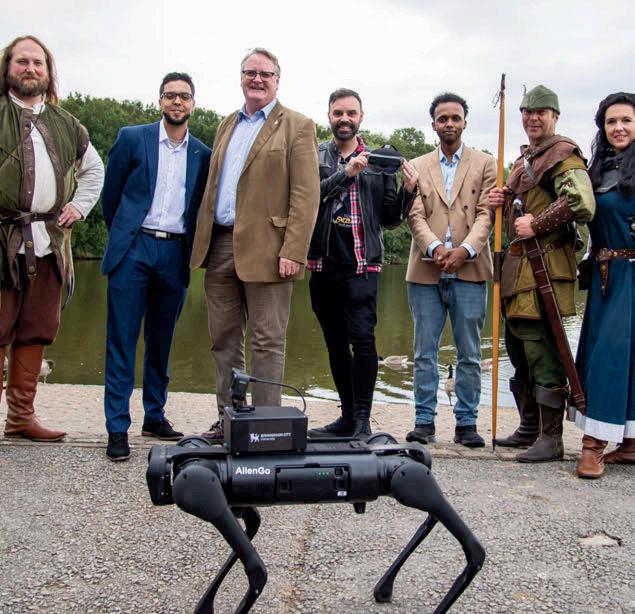Innovation Briefing
LIGHTING UP 5G ACROSS THE UK
























It’s time to enjoy the thrill of connecting face-to-face and creating eureka moments together again. DTW 22 is the place the industry come together, where you can connect with your peers to co-create and do business.
If it can be done on zoom, we don’t want it in the room.



• Our most diverse speaker line-up ever is taking the stage, from the C-suite to DevOps team, this is where the industry meets.
• Hear from 200+ trailblazers across three summits, including speakers from Google, AWS, Rakuten Mobile, Sparkle, Colt, BT, Vodafone, and more.
And, it’s not all work and no play. Introducing the quad – our brand-new expo experience.
• Explore the latest tech innovations from 100+ exhibitors, hyperscaler partners, including Microsoft, AWS and Google, 27 proof-of-concept Catalysts and our startup pavilion showcasing the latest in disruptive tech.
With thanks to our event sponsors: Diamond Platinum CSP partners




BUILDING ON THE SUCCESS of the 5G Testbeds and Trials programme, the new Telecom Infrastructure Network is an important new approach for the UK. But it has come at a time of great change. When Testbeds and Trials was ramping up we were, even if we didn’t know it at the time, in a period of comparative stability. Today we face the opportunities and challenges of being post-Brexit and post pandemic, the uncertainty of rising costs of capital and resources, and the reality of conflict in Europe. Various parliamentary reports have concluded that the nation cannot be reliant on just Nokia and Ericsson. While the 5G Testbeds and Trials enjoyed the opportunities of this previous period, the Open Networks Research and Development Fund is born into a time of pragmatism.
To meet these challenges, we are in a second phase with a new management team, new stuff launched, 5G testbeds and trials put to bed, and the Future Networks programmes awake and getting going. Where we are going is laid out in the UK Open Networks R&D Fund Prospectus

“Accelerating the pace of telecoms innovation”, we have the Future open network Challenge, the Korea competition.









I’m delighted that the projects FRANC, SONIC and NeutroRAN are already collaborating. They have identified the need to be efficient, pragmatic and dedicated. Only if we can demonstrate real commercialism for what we are doing can we look back in three years and see the Open Networks Research and Development Fund as a success. We’ll need products, IP and revenue streams. We’ll need to demonstrate that what we’ve developed is important for the country. And we need to do it in the allotted timescale.






Part of the opportunity here, and a lesson learnt in Testbeds and Trials, is that we are no longer tied to 5G. That question of “why do you need 5G to do this” has gone away. We are now looking for the right technology to solve any given problem. This can be 4G, WiFi, LoRa, Satellite, Fixed, and of course 5G or whatever is suitable. Delivering an appropriate, resilient supply chain with secure technology is a matter of national security.
We are building a UK ecosystem, so the project’s first port of call with suppliers needs to be as close to home as possible. There is nowhere closer than the other projects in the FRANC programme. One of the things we learnt from Testbeds and
Trials was that the organisations that worked well both together and with each other became more than the sum of their parts.



Key to this was UK5G and for the future it will be UKTIN. This is the organisation that is taking over from UK5G. It comprises Cambridge Wireless, Digital Catapult, the University of Bristol and West Midlands 5G. All of which have been heavily involved in UK5G. So I expect the transition to be smooth. When looking for help your first port of call should be UKTIN.
Fortunately, we go into this period of extreme uncertainty with an army of people who’ve been through the 5G testbeds and trials. They are skilled and knowledgeable in the implementation of the technology. We are ready to build..
 Keith Bullock Future Networks Programmes Programme Director DCMS
Keith Bullock Future Networks Programmes Programme Director DCMS
Head of UK5G Robert Driver


Head of Marketing Vicki DeBlasi
Content Creation and Curation
Crispin Moller
Lauren Kelly
UK5G Social Media
Kate Cartwright Administration
Emma Dexter
Contact: www.uk5g.org/about/contact/
c/o CW, Bradfield Centre, 184 Cambridge Science Park, Cambridge CB4 0GA
T: +44 (0)1223 967101 W: uk5g.org
Kate Bealing
Mija Valdez
CWJP
Chairman
Keith Young MBE
Editor
Simon Rockman simon@cwjp.co.uk
Creative Director
Matthew Inman
Business Development Director
Roger Hinkson roger@cwjp.co.uk
Finance Director

Delia Robinson
Photography
Stuart Berman
CWJP
14 Great College Street, London SW1P 3RX
T: +44 (0)20 8002 0000 CBP006075

No one likes waiting at traffic lights, least of all former Minister Matt Warman
Meet the people rising to the supply chain diversity challenge, as they really get motoring with their projects.
26
Space is big. really big, and it’s just becoming relevant to cellular mobile. Vodafone and AST, Elon Musk and T-Mobile are working on direct to space cellular networks, while British company Bullitt anounces a world first. 40

Liverpool 5G as built Europe’s largest 5G Standalone private network. It was designed to support the NHS with health, and particularly social care. But when the pandemic struck it was repurposed to support children learning from home. Jaine Pickering investigates.



The Testbeds and Trials have pioneered many aspects of 5G technology, often first of their kind use cases and working with new suppliers. DCMS and UK5G have worked to share the knowledge and build the ecosystem.
Smart Wireless Innovation Facility, or SWIFt is a 5G equipped incubator at the Nottingham Trent University Clifton campus. It has been designed as a living lab for researchers, businesses and policymakers demonstrate who the latest technology can be deployed and used.

UK5G INNOVATION BRIEFING IS PUBLISHED BY CW JP ON BEHALF OF UK5G, THE NATIONAL INNOVATION NETWORK FOR 5G . ALL RIGHTS RESERVED. ARTICLES MAY NOT BE REPRODUCED WITHOUT WRITTEN PERMISSION FROM CWJP. OPINIONS, COMMENTSAND VIEWS INCLUDED IN THE JOURNAL ARE NOT NECESSARILY THOSE OF UK5G
Protecting the nation against cyber attacks is the role of The National Cyber Security Centre, part of GCHQ. Technical Director Ian Levy explains the balancing of threats from a limited supply chain against the increased vulnerability of open architectures.



DIVERSITY MEANS DIFFERENT things to different people. In the mainstream it’s about having people of different races, backgrounds and cultures working together.
To radio engineers it’s a property of antennas placed less than a wavelength apart to interfere with one another and so increase their range.
For some Diversity is the Britain’s Got Talent dance troupe that pipped Susan Boyle in the 2009 final.
And to those concerned about the lack of choice when buying mobile equipment and services it’s aboutfinding alternatives to the main global players, namely, in the UK, Nokia and Ericsson.
It’s the third model of diversity – supply chain diversity – that has been exercising the British mobile industry.The problem is that there is not enough competition in the mobile industry. Thirty years ago there was plenty of choice: Siemens, Motorola, Alcatel, Marconi, and more. There were perhaps a dozen vendors who would sell you a 2G network.
The mobile industry has grown like crazy. In his book The 5G Myth, Professor William Webb gives a figure of $20 a month as the amount spent per person across the world. Given that there are more than six billion mobile phone accounts that’s $120 billion dollars a month coming into the industry.

So where did it all go wrong? Why did this fabulously wealthy industry find itself in a position where the people who made the equipment couldn’t make money? Strangely for such a big question there is a one-word answer: consolidation.























Mobile networks used to be something only large multinational corporations could build. Now the option is open to compaines, campuses and communites. Simon Fletcher and Caroline Gabriel look at the questions you should ask when buying a small cell and we list the companies who can supply the apparatus.

Over the past two decades, the major mobile networks have bought one another. Fewer bigger network customers was bad for supply chain diversity: as the significantly more powerful customers used their position to grind down margin.
Vendors found themselves looking at the prospect of either taking a job worth hundreds of millions of dollars and making next to nothing on it or seeing the work go to a rival.








This led to an industry death spiral. Only Nokia, Ericsson and Huawei survived. Many vendors looked at the huge investment necessary to move from 3G to 4G and decided it wasn’t worth spending the money on a loss-making business.
That’s where we are today, but not where we will be tomorrow. Two things are changing. The first is the government-led programmes to build a supply chain, but just as important is the future of those providing the coverage. In a model of a network of networks, where there is a diversity of customers there is more opportunity for the new generation of suppliers to find customers looking to fill the gaps left by the major mobile networks.


All good things come to an end and UK5G was a very good thing. It showed that even with the best possible communications there is a value in meeting face to face and then while we couldn’t do that it found ways to create as much of the value possible through virtual meetings. The result was a community which worked together to learn about 5G. As UK5G concludes we look forward to UKTIN.
Just as diversity of race, gender and culture is important, just as the radio propagation of antennas using diversity is a tool in deployment and just as a diverse choice of suppliers is key, a diverse number of customers is important too.
GOOGLE IS TRYING TO shame Apple into opening its proprietary iMessage service and adopting RCS, the messaging stack originally devised by the mobile telco industry. “It’s time for Apple to fix texting,” is the banner of the Google-funded site, Get The Message (https://www.android. com/get-the-message/)


While iMessage users can exchange messages from a variety of Apple devices, the vast majority of mobile users in the world are on Android. But they are represented to iMessage users as a “green bubble”, meaning they cannot receive rich media or participate in group chats without risking mobile network charges.
Apple internally acknowledged that interoperability would “remove [an] obstacle to iPhone families giving their kids Android phones,” according to one executive. Moves to impose messaging interoperability were added to the EU’s Digital Markets Act earlier this year.
RCS was originally announced in February 2008, before Apple had even opened the Apple iPhone app store. Conscious of the poor take-up of MMS, which operators saw as a profit centre, and fearful of over-the-top messaging services, the operator industry
developed the RCS suite, enhancing basic SMS messaging with group chats and rich media.
The result was a complex, multi-layered specification exceeding 2,000 pages of documentation, which nevertheless did not include international interoperability – a default feature of IP-based messengers such as WhatsApp and which only came a decade later in 2018.
As a result of the flop, free-to-use IP-based messaging services such as BBM, then
WeChat, WhatsApp, and Facebook Messenger proliferated, guaranteeing users interoperability and no hidden billing costs.
Google isn’t as altruistic as the marketing campaign suggests. It effectively took control of the RCS specifications three years ago, and RCS messages now run through Google’s servers. It also follows years of failure as Google launched successive over-the-top messaging clients: GTalk, Google Voice (with its own messaging client), Hangouts, Allo, and Duo all failed to impact the market.
RCS was incorporated into its Android messaging client in 2019 (as optional “chat features”) and gained end-to-end encryption (E2EE) for 1:1 conversations last year. But beware: RCS is now a proprietary Google service, Ron Amadeo at technology publication Ars Technica pointed out: the only third party allowed to integrate with it is Samsung, thanks to a private agreement.
“Other than Google being desperate for one of the few messaging solutions it hasn’t exhausted with mismanagement, there’s no clear argument for why RCS is worth this effort,” he wrote. Amadeo joined calls for Apple and Google to work together on an entirely new standard.
www.android.com/get-the-message
An uptake in the niche practice of using mobile networks to replace cable or DSL has prompted Barclays to downgrade expectations of the share prices of US cable operators. Such offerings are called FWA, or fixed wireless access, and Three first launched 5G in the UK as a domestic FWA broadband package, rather than an upgrade for mobile phone users.
US mobile operator T-Mobile added more FWA customers in the most recent quarter than Comcast or Cable expect to add in the entire year. Additions in the fixed line market are largely fuelled by house moves. The additions are lower than expected, and the FW additions higher than expected. Barclays Group media analyst Kannan Venkateshwar was one analyst to adjust his equity ratings.
T-Mobile USA added 560,000 fixed wireless subscribers in Q2, far exceeding consensus expectations. Shipments of FWA modems are expected to double in 2022 to 3.6 million, according to the GMSA, although today most remain 4G only.
The prediction is based on a survey of vendors. Almost one in ten US households may be using FWA as their main broadband connection by 2026, according to analysts Global Data.

TWO OF THE UK’S FOUR mobile network operators now claim to have reached half the population of the UK with 5G.
Hutchison-owned Three says it now reaches 56 per cent of the population, one percentage point higher than the 55 per cent that EE claims to cover. O2 and Vodafone can claim to cover around 35 per cent of the population, according to a RootMetrics, which has been acquired by speed test company Ookla, in a survey conducted over the first half of 2022.
RootMetrics data also confirmed that Three has the highest peak speeds for 5G, with a median download speed of almost 200 Mbit/s. O2 came bottom with 110 Mbit/s. Ookla confirmed that Three delivered the fastest download speeds, although it placed Vodafone in first place for upload speeds.
URSULA VON DER LEYEN , president of the EU, is on a charge to save energy and the planet. And in her sights are the way we use and repair mobile phones.

As part of the EU Ecodesign Regulations, the European Commission is looking for a 25 percent reduction in the power used by mobile phones, tablets and cordless phones by 2030. Using 2020 as a baseline this would see consumption drop from 39.5 TWh to 25.4 TWh.
But it is the repair of mobile phones, a recognition that consumers want to have the same device for longer, that has the biggest impact on the industry.
The proposals look to equip registered, professional repairers with the skills, tools and
parts to maintain a phone for at least five years after a device is removed from sale, with comprehensive details on how to take apart, repair and re assemble phones and tablets.
Replacement of batteries will have strict rules with the devices where batteries are more prone to needing replacement will have to be simple for the layman to swap. Allowance is made for ruggedised phones. Consumers are looking to use their phone for longer and upgrade less often, in part because model to model improvements are less significant than in 2G and 3G devices. : https://op.europa.eu/en/publicationdetail/-/publication/955d36e7-2906-11ed8fa0-01aa75ed71a1/
Despite inflation-busting price increases, the UK mobile consumer has seen the cost of data fall, according to a report from Cable.
“Contrary to what one might expect as the cost of living continues to rise, the average package cost has fallen, from $23.28 to $17.58,” said analyst Dan Howdle.
Cable surveyed 58 UK SIM-only consumer plans, and compared them with plans from providers in more than 100 other countries. These were then converted to US dollars as a reference currency. The numbers exclude roaming costs.
The analysis priced mobile data in the UK at $0.79 per GB, a significant fall from 2021, when it was calculated to be $1.48/GB. The average package had fallen in price from $21.28 to $17.58.
But this places the UK behind France ($0.12/GB) and Italy ($0.23/GB).
The high costs of mobile data in Sweden ($1.88), Germany ($2.67), Belgium ($3.00) and Switzerland ($7.25) may reflect local purchasing power, as well as a less competitive market. Israeli mobile pay consumers pay just 4c for a gigabyte of mobile data a month.
None performed well with latencies of 40 milliseconds, however. That’s a far cry from the promises made at launch.
“With 5G’s sub-5 or sub-2 ms latency, you can get live 3D video to your fully wireless headset and experience events in real-time –kissing goodbye to motion sickness,” one mobile network promised as it turned on 5G in July 2019. The benefits are real, but theoretical unless the network moves to the newer 5G Standalone technologies. Ookla found median latencies of 29ms for Vodafone and EE, 32ms on O2, and 35ms for Three.
SOME PARTS OF THE population have concerns about the potential health effects of the RF exposure, in particular that of mmWaves, related to 5G.

The European Union recognised these concerns and provided funding in its Horizon Europe research programme for research in this area.
GOLIAT (5G exposure, causal effects, and rIsk perception through citizen engagement) is a five-year project aimed at providing responses to some of the questions raised by the new wireless technologies, with a special focus on 5G.
The aims of GOLIAT are to monitor radiofrequency electromagnetic fields (RF-EMF) exposure, particularly from 5G, to provide novel insights into its potential to affect health and wellbeing, and to understand how exposures and risks are perceived and best communicated using citizen engagement.
Part of the GOLIAT project focuses on two particular societal groups: (i) young people who could be more susceptible to the effects of RF-EMF, and (2) workers and industry, for which
particular industries, occupational settings or scenarios could result in high exposure levels or abnormal exposure patterns.
GOLIAT is led by the ISGlobal institute in Barcelona and involves 22 institutions. The University of Bristol leads the work on the use of 5G in industry and for workers and will focus on developing and conducting exposure measurements and neuropsychological and wellbeing effect studies in worker populations exposed to 5G.
Professor Frank de Vocht of the University of Bristol told us: “To obtain as comprehensive as possible a picture of 5G implementation and developments in industrial settings, we are keen to discuss the application of 5G with representatives of industries and companies that have implemented 5G or are planning to.”
If you are interested in discussing EMF effects or would like to know more about the GOLIAT project, email Professor Frank de Vocht at frank.devocht@bristol.ac.uk. The project brief is available at www.isglobal. org/en/-/5g-exposure-causal-effects-andrisk-perception-through-citizen-engagement
A consortium of industry and German academic research institutes has identified six key areas for R&D work for 6G. The 6G Lighthouse Project brings together vendors Nokia and Ericsson, and 15 universities and research institutes, with Nokia chairing. Codenamed Anna, the initiative wants to “drive global pre-standardisation activities from a German and European perspective”, mirroring national efforts in France and Spain. Standardisation work for 6G only commences in three years’ time; there’s lots of 5G to do first, before it can deliver on even a fraction of the promise. The most significant milestone will be v5G Advanced in 2024.
www.nokia.com/about-us/news/releases/2022/07/11/nokia-to-lead-german-6g-lighthouse-project/
Market challeneger Xiaomi has demonstrated 210W charging. Using its 11 Ultra mobile phone, the company reports charging the 4,000 mAh battery from 0 per cent to 100 per cent in 8 minutes. The rapid charge showed 210W of power and received a certification as well. This makes it the fastest charging that has yet been demonstrated.
BT has claimed a breakthrough in aggregating four different spectrum bands on a 5G standalone network for the first time.
Pooling the bands allows for greater throughput and efficiency. The successful trial, using Nokia radio equipment and a MediaTek 5G modem, took place at BT’s Adastral Park centre in Suffolk. It aggregated 2.1 GHz, 2.6 GHz, 3.4 GHz, 3.6 GHz bands on EE’s network.
MediaTek’s M80 chip provided the “handset”. A lab test in March demonstrated transmission speeds of almost 3 Gbit/s on the downlink. Lower bands penetrate walls better, while the higher bands provide additional capacity.
Amazon has finally launched its widely anticipated “5G in a box” service, AWS 5G Private, in its first market, the United States.
The US is well suited to this approach as CBRS spectrum licensing allows free access to unused frequencies.
The service is intended to allow organisations to design and deploy a 5G private network with little or no expertise, with the deployment and management handled remotely by Amazon’s AWS service.
A blog post by AWS’s Jeff Barr demonstrates how a new network can be specified and ordered with just four basic web forms. Amazon bills $10 per hour for each radio unit.
While it supports only 4G for now – 5G is coming – it is a landmark in taking cellular industry technology and making it widely available for private commercial use Amazon claims a watching brief for the UK.

and expense of starting from scratch each time. Critically, however, they should only ever be treated as a framework to start conversations. Eynon offered this guidance: “Know your context, know who you’re dealing with, know the challenges on them and what’s going to be possible.”

Dunn highlighted that although Eynon’s work is in very different regions, there are some common learnings that others can build from, such as a recognition that standardised templates can only ever be templates: they start off conversations but there will always be unique factors that come into play for specific sites, and authorities need to be empowered and capable to adjust the templates to work for them.


PROGRESS IS BEING MADE in the project to help local authorities manage sites that can be used to expand the mobile networks. The goal of the programme is to provide organisations with the tools and skills to digitally manage public sector assets through testing of different approaches.
At a face-to-face event in Bristol in June, more than 100 people from regional and local authorities, the telecoms industry, government and other stakeholders caught up on developments.



A panel that included four mobile network operators was chaired by Gareth Elliott from Mobile UK. It was followed by a crossgovernment panel that included Building Digital UK, the DfT, the Barrier Busting Task Force and the National Underground Asset Register, chaired by Nick Wiggin from DCMS.
“It was a fantastic occasion,” said Wiggin, “a genuine sense of the industry and government coming together to drive forward digital connectivity. The face-to-face networking elements were incredibly well-received and the main piece of feedback was to do more in-person events like this, to drive collaboration.”
That collaboration was demonstrated by the presentations. Gary Littledyke from Wessex and Lynne Wilson from West Berkshire explained that the key to success in asset data collection is thinking strategically about what
data will provide the greatest value, rather than just collating everything available. They explained how contextualising data can improve the process for infrastructure providers, and there was a real sense that now is the time to develop these asset management platforms.
Nicola Scullard from West Sussex talked through her consortium’s approach to mapping process workflows and measuring the improvements. She observed that the team who looks after an asset is not likely to be the one that makes a decision on using it. West Sussex has therefore decided to develop a bespoke product to deliver the requirements of all the councils who would eventually use it, and is working to ensure processes are built into the product from the start. Scullard said the benefits of the pilot will be measured in terms of making things quicker: “how we can remove steps, streamline and make deployments more quickly”.
A key to working together and reducing the process overhead is having standardised commercial models for access to assets, and this subject was co-presented by Sarah Eynon of Scottish Futures Trust Infralink and Lucy Dunn from the West London Alliance.
It was clear from their presentation that standardisation of contract templates can help to streamline processes and avoid the time









There is an irony in the term “digital asset management”. Traditionally this means the management of assets that are in themselves digital – artwork, logos, intellectual property and the like. When Antony Corfield from the West of England Combined Authority and Vasilis Papakonstantinou, from West Midlands 5G talked about enabling local authorities to support digital asset management they were discussing the digital management of physical assets, typically bus stops and street lights. Corfield reflected on how the industry could help local authorities. “There needs to be recognition that there are constraints in the public sector,” he observed, adding that an openness to dialogue means all sides can achieve what they need more quickly.
Both presenters agreed that it would be valuable for industry to consider how to create more win-win situations for local authorities, especially in supporting those who may not have the connectivity know-how.
Turning to central government, Papakonstantinou highlighted the value of events such as this to disseminate information to leaders, to ensure they are equipped with relevant insights and empowered to build their own digital strategies. He added: “It would be great to see digital champions everywhere. If central government had a way of monitoring this, it could identify gaps and intervene to try to direct places to take the successful actions we’ve seen elsewhere.”
A more in-depth write-up of the DCIA Dissemination Event can be found on the uk5g.org website.

If you would like to get involved in the DCIA programme, please email dcia-info@dcms.gov.uk











MATT WARMAN TALKED about a number of significant announcements when he attended the Testbeds and Trials at the Smart Junction 5G conference. These include the £250million Open Network R&D funds supporting the supply chain diversification strategy.
Reflecting on a comment from EE’s Andy Sutton that Open RAN is not ready for prime time right now, Warman said: “It is that money that the UK is genuinely trying to lead the world with, to get some of that work done faster than it could be done elsewhere. The Future Open Networks Challenge, £25 million for research, will take these things further and faster to embed greater openness and interoperability into networks from the start. It is a really important part of working with academics, with researchers, and with telecoms companies to make that open by default.”
The aspiration is to enable the UK government and industry to draw on a more diverse range of vendors, and built into this is compatibility testing.
Warman also looked to the benefits of working internationally. “It’s critical that countries work together, the private sector as well as the public sector,” he said. “We have a project with the Republic of Korea on the cutting edge of R&D that is hugely important.
Samsung is obviously an enormous player in this area. It’s brilliant that we were able to work alongside the Koreans to make that a reality.”
He also talked about TIN, the £10million Telecommunications Innovation Network competition with Digital Catapult, Cambridge Wireless, the University of Bristol and West Midlands 5G working together to establish and oversee that network which was recommended by the diversification task force.
Ministers are not supposed to have favourite projects, but it was clear at the 5G Realised conference last year that Warman, then Minister for Digital Infrastructure, had a soft spot for Smart Junctions 5G. In the topsy-turvy situation with ministers of the midsummer we saw his replacement resign, Julia Lopez and Warman slot back in, he’s now reliquished the position once more to Julia Lopez
The Smart Junctions project demonstrated a use case and addressed both the challenges and benefits of open networks. Led by sensor and software AI technology company VivaCity, the project showed the benefits of real-time traffic control and the cost savings from rolling out smart junctions. The use case proved the business model and it is hoped that the project will be expanded. The key metric is that the technology cut journey times by up to 23 per cent. The implementation of the 5G private Open RAN network took a multi-vendor

approach, looking at cutting the cost and making that scalable, and to address security VivaCity worked with its suppliers to prioritise cyber security - Weaver Labs led the security work package
The project, much like Liverpool 5G, has also demonstrated to the local authority the benefit of owning and managing the network to be able to use it for their own use cases, cut their costs, benefit from enhanced connectivity, and also to be able to rent out the capacity.
The VivaCity vision-based sensors have core capabilities to count, track and classify various modes of transport. They are adaptable in their approach: things such as air quality, sustainable modes of transport such as bikes, pedestrians and e-scooters, or even haulage prioritisation. There are more vehicles on the roads these days and the technology used to manage them has been around since the 1990s. The step-change deployed by VivaCity is a reinforcement learning approach to traffic signal control. If we look back at coordinated traffic control in the 1990s, it was very much congestion-focused. The automation for the time was unusual and meant the high costs were favourable. They were accepted. Roll forward to today and it’s a very different world we’re experiencing.
The VivaCity traffic optimisation model builds from a single set of traffic lights through local to citywide and regional. Each smart junction has a virtual occupancy zone to see how the movement of traffic and queues change throughout the day. This isn’t just traffic, it includes pedestrian and cyclist zones. The modes of transport are identified at the edge and the data sent to the cloud where the VivaCity reinforcement learning agent sits. It takes that raw data and decides on an action based on the training that’s been in simulation. Simulations are run before deploying anything on the street so as not to cause major accidents while training and validating the system for real world control. The agent makes a decision and sends it down to the traffic controller cabinet to control the traffic lights.
As part of this project, VivaCity has been developing the user interface that Transport for Greater Manchester can use daily to analyse what’s happening in its network. It feeds through live occupancy data on different arms of the junction and can be used to validate what sort of decisions the agent is taking to see that it’s making sensible actions based on
the occupancy. Traffic is controlled in stage movements and phase movements. Latency graphs show real-time analytics of what is happening with the network.
The first deployment, for Testbeds and Trials, has been on a busy stretch of the A6 in Salford, Greater Manchester. It’s a main corridor to the city centre which gets very congested and there are many network issues because of the geography, Salford University and multiple train stations along the route. There are nine smart junctions, with 57 sensors to cover every single one of those junctions, including their upstream to collect journey time data.
VivaCity developed and repackaged the Benetel 5G equipment and is looking to further development to integrate 5G technologies into production hardware. It has to be 5G to give the low latency for a real-time connection, and because the available N77 spectrum uses 5G equipment. In Cambridge and Peterborough VivaCity has used a wired ethernet connection but has found this prohibitively expensive to scale, with lots of unknowns in terms of ducting and infrastructure which derail timelines and also costs. Although much more scalable, a public network offers its downsides, as experienced in instances within other smart junctions trials due to it being susceptible to congestion at peak times – precisely when the real time data is most needed. It has proved its worth with significant reductions in journey times and reduced pollution from vehicles idling at lights. VivaCity expects that as more coordinated junctions are added there will initially be a multiplier effect on improvements in traffic flow until an optimal level is reached.
Weaver Labs’ core expertise is networks and software. Its skillset was the right one not only to deliver a network that could deliver the objective of VivaCity’s use case but to work

alongside TfGM on the strategy setting for the whole region and a new outlook for innovative business models in telecoms. Weaver Labs brought its technical and commercial proved to be a necessary combination to make this project a long-term success for private networks in public sector. On the technical side, Weaver Labs delivered a pioneering setup, highly innovative, scalable, replicable and affordable using edge-cloud for OpenRAN. This was surrounded by challenges which were presented in the lessons learned panel at the event. All project partners as well as DCMS agreed that OpenRAN technology is in its infancy, and the partners showed resiliency and adapted the project’s objectives and ambitions to deliver despite this. Hannah Tune, from TfGM underlined the lack of skills within the public sector to deploy and manage telecoms infrastructure and how up-skilling has been central to this project
On the commercial side, Weaver Labs and TfGM proved the business case for publicly owned networks. This has been a topic of interest not only for Manchester but also widely discussed in the UK. It was demonstrated that a 5G network built using

publicly owned assets, and operated using CellStack (Weaver Labs’ cloud-based management tool) can provide all the value added to the city, while showing significantly improved costing model. The 5G Smart Junctions solution scales, because is based on infrastructure sharing and a collaborative economy.
MOHAMMAD LARI, former Head of CrossGovernment and International Coordination for the 5G Testbeds and Trials Programme, looked at the bigger picture into which Smart Junctions 5G fits “DCMS and the investments that we’ve made over the years, the policies and the strategies that we’ve developed in coordination with the investments and policy thinking that the industry has done, the local authorities have done and reverted back to us with.
“All of that accumulates into strategic aims and those aims are threefold,” he explained, and he laid out his three elements for sustainability. The first being a catalyst for change. “That catalyst is based on real challenges, whether it is the challenge for an individual or a community. It’s the only way we can achieve greater sustainability of the environment that we live in, or the technologies that we utilise. There needs to be a challenge.”
The second element for sustainability Lari highlighted was the people: “It’s the creative spirit. It’s the individuals behind the change, who recognise that there’s a change and they want to do something about it. And they want to do it in a way that perhaps has been tried and tested, but they want to tweak it, or something that they’ve come up with on their own, or something that’s just an effort, perhaps not getting to the right solution on day one, but getting to it eventually.”
His third element is perhaps the one most identified with the Testbeds and Trials Programme. “The third part of a sustainable solution is innovation, to drive growth. Innovation to drive the economic recovery for the country, and also the economic recovery of the local communities that we reside in.”



The Smart Junction 5G conference formed something of a bookend, with Lari looking back at the legacy of the 5G Testbeds and Trials and Warman looking forward to the new Future Networks programmes. But whatever part of the programme it forms, there was universal agreement that less time spent waiting for traffic lights to change is a very good thing.

Technology is at the heart of what citizens want to see in almost every aspect of public services. This program has had a practical impact scalable across the country.
Getting projects together to foster collaboration has been part of the success of UK5G and will form a major part of the new UKTIN organisation. The first event under the Future Networks Programmes saw the first opportunity for projects to meet each other and key people from DCMS. If you couldn’t make it to the event, or even if you did, here are the people you need to speak to, to build the ecosystem
David Owens, of Virgin Media O2, explained the challenges of integrating national mobile networks with small private ones. His project is working with Wavemobile, Cisco and the University of Warwick, with a particular focus on security. He told the event: “5DRIVE will provide a great way for new and old vendors to enter the market with a cost-effective, scalable, secure solution. This will be the first time a private network will be connected using a new architecture.”
>> David OwensA collaboration between Telet, AccelerComm and cellXica, this is a project to build the M5Q, a small British-developed, designed and produced cell aimed at the new generation of small networks.
It will use leading-edge firmware to maximise energy efficiency and lower running costs. One of the experimental aspects will be the ability to manage frequencies in a collaborative process with other cells in the area to provide maximum spectral efficiency, opening the way to new licensing models.
>> Andrew Miles, Julia Cordall, Peter Gradwell





ARI-5G, or Accelerating RAN intelligence in 5G, has a goal to test and measure performance of 5G RAN in lab. It will concentrate energy efficiency, spectral efficiency and interference management. The project is looking to engage mobile operators to help them lower running costs. It is also looking to work with developers to try to reduce their physical dependency of networks and come up with great xApps and RF use cases. Led by the Telecom Infra Project, there is an emphasis on open networks: “We want to establish multivendor open RAN That is about being interoperable, interchangeable and integrable.”
>> Osman TaherGraham Currier, Chief Operating Officer of Dense Air, explained that the CoMP-O-RAN project is built around small cells that co-operate, working together to extend the range of individual components. Glasgow University is writing the algorithms with partners Blu Wireless on mmWave, Airspan on 5G NR, and Radisys on the software stack. Currier recognised that the result has to work economically as well as technically. He explained: “We have labs already constructed, lab work starting, and field trials will be held at Millbrook Proving Ground.”
>>
Graham Currier
The “Distributed Unit” or DU performs signal processing, converting radio signals to data traffic that can then be transported by to the core network infrastructure.
Working principally with UK-based vendors, it will integrate products into an operational Distributed Unit component that is ready for deployment in 5G networks.


Led by ADVA Optical Networking, the consortium comprises AccelerComm and CommAgility, both of whom are experts in the deepest level of cell architecture, along with BT and the University of York.
Scotland 5G Centre provides a project management function of co-ordination and leading collaboration with other projects and organisations.

Testing of the DU will initially be conducted at labs in the North of England supported by ADVA UK, with later testing taking place at BT’s Adastral Park facility.
>> Abigail Elcock, Eric DowekFlex 5G
Ecoran, or energy-efficient cloudlets for open radio access network, is building energyefficient processing that connects servers in cellular passive optical network which it refers to as CPON.
By applying machine learning the architecture reduces the energy by 82 per cent. The infrastructure provides 100 times faster interconnection between servers, and 60 times faster intensive computations by eliminating the hierarchy of switches used in the centre architectures. If deployed worldwide the reduction in emissions would be equivalent to those of a country the size of Greece.
Key to this is reducing the underutilisation of resources within data centre. The project is talking to Rolls-Royce, Jaguar and Ford and Nissan, and working closely with the High Value Manufacturing Catapult.

>> Abdelrahman Elgamal, Azza Eltraify, Sanaa Mohamed



The biggest project in terms of partners, Flex 5G brings together systems integrators AWTG, Vodafone and Virgin Mobile O2, along with Zain from Saudi Arabia.
The roll call adds Lime Microsystems, University of Surrey 5G..6GIC, CommScope, Viavi, Emirates ICT Innovation Center (EBTIC), Amazon Web Services and Cambridgeshire County Council. As one might expect it’s an ambitious project building and combining the components for a full 5G Standalone network. With a mix of partners ranging from a silicon supplier to hardware providers, as well as those who provide the novel algorithms and the software solutions that sits on top along with the eventual customers for depolyement: the organisations that could test those and verify the applicability of these types of solutions out in the field it’s an end-to-end programme for building, testing and using a full 5G network.
>> Colin Bryce, Karolis Kiela, Marcin Filo





Swindon-based AceAxis, in partnership with MAC Limited, will build a Future RAN Advanced Test system, for use by radio network equipment vendors who are designing, building and testing 5G Future RAN radios.
AceAxis has a long history in designing and building cells, often licensing those designs to major vendors. Through its work, building both radio heads and distributed units, the company has learnt a lot about working to EU and Open RAN standards.
The consortium is using this expertise to build test equipment for the wider industry. It hopes that this will lower the barriers to entry for smaller vendors and help grow the open RAN community.

Future RAN interfaces are clearly defined. Using these interfaces, along with 3GPP definitions, provides the opportunity for the Open RAN Advanced Test System to become a trusted industry standard for developing 5G radios.
>> Choong Wong, Steve Cooper

The GaN in the name is Gallium Arsenide, a compound semiconductor that has some advantages over silicon for making chips. It provides faster switching and handles power better, but cannot be used for making central processing units.
In mobile device design, GaN is an important technology. And there is a facility for making the chips near Newcastle. The project is working to repurpose designs for radar. The project is led by INEX Microtechnology, working with Custom Interconnect, Viper RF and the Compound Semiconductor Applications Catapult.
The current chip shortage is forecast to last at least 10 years and to worsen. Having UK-supplied chips is essential for national security. The project will develop Monolithic Microwave Integrated Circuits, or MMICs, to remove the threat of supply shortages.
The consortium is particularly looking to supply its components to other projects developing products as part of FRANC.

>> Andrew Stokes, Andrew Whitworth, John Boston, Roger Carline, Andrew Thomas


This project is creating an architectural blueprint for multi-domain public and private 5G networks with multi-vendor integration, interoperability and satellite backhaul.
The partners are Cellnex Connectivity Solutions and working with the University of Bristol, Attocore, Weaver Labs, Satellite Applications Catapult and Parallel Wireless.
Cellnex has extensive experience of working with the major mobile network operators to install private networks, including at the Etihad stadium, on the Brighton mainline and at Bristol port.
Andrew Thomas from Cellnex explained: “Our impact in the market is to create use cases to demonstrate that network resources can be shared between a public MNO and private network.”
The project will use novel backhauling and neutral hosting services with a particular focus on satellite backhaul (mainly GEO and LEO constellations) for connecting to different core vendors. The team is looking to work with developers to exploit its framework for secure xApps running on the platform.
>> Andrew Thomas, Ashweeni Beeharee, Jeff Land






This project uses artificial intelligence and machine learning, along with the latest advances in cloud technology to optimise the network more efficiently.
The ability to swap components in and out of the design of a mobile phone base station adds flexibility, reduces the build cost and, most importantly, adds to the security of the supply chain. But it’s not usually possible. Cells are designed around a particular chip and changing that would require a ground-up redesign.
Justin Sims, a systems engineer from Parallel Wireless, explained that Proteus is a project to abstract the specifics of chip-level components from the overall design. He explained that initially this was for x86-type chips but that an ARM based PCI accelerator card was the next step. The programme is looking to demonstrate that performance is not impacted by the abstraction layer.
The consortium is led by Parallel Wireless with ARM, BT, the University of Bristol, Wireless Excellence and Real Wireless.
>> Hamid FalakiThe consortium will develop a full 5G Open RAN platform that uses Software -Defined Radio to produce a signal across a wider range of frequencies, up to 10 GHz, than is typically available.
The project will deliver an innovative solution for Open RAN, which will reduce costs for owners, break single dependencies, and disaggregate hardware and software.
This will allow infrastructure manufacturers to build more efficient mobile base stations which work across more frequency bands.
Led by the Compound Semiconductor Applications Catapult, the consortium also comprises Lime Microsystems, Slipstream Engineering Design and quantum cryptography experts Arqit. CSA Catapult is a test and support facility that pulls in many industry experts to provide feedback and advice on direction and progress. Slipstream Design is providing a software-driven and frequency-agnostic power amplifier
Lime Microsystems is offering a highly integrated developed power radio chipset and modules for fully programmable solutions.
The project’s goal is a full platform without the limitations of a traditional vendor.
>> Andy Sellars, Ayan Ghosh, Fatemeh Hoveizavi, Graham Peters, Sally Roberts, Scott Alexander, Simon Maggs




The “Towards AI Powered and Secure Carrier-Grade Open RAN Platform” consortium brings together Metaswitch, which was acquired by Microsoft in July 2020, Intel R&D, Capgemini and the University of Edinburgh.



The programme is looking at pulling together open components from a large number of sources and managing them centrally with a single dashboard.
The integration makes sure there is security running through the whole system. It pulls together core network functions, billing and edge into a single system and uses artificial intelligence to co-ordinate the monitoring.
Adding new functionality should be easy. Bozidar Radunovic, principal researcher at Microsoft Cambridge, told the event that the with the platform “anyone can deploy a grand virtual function on top of the platform without having to do any special configuration”.
He added: “The second goal, also paramount for an open architecture platform, is security. We want to make sure the open platforms and components running on them are secure: the billing process, in terms of attack protection, in terms of the usual security and trust, we have all certain contexts with other platforms in the cloud.”
Innovate UK KTN exists to connect innovators with new partners and new opportunities beyond their existing thinking – accelerating ambitious ideas into real-world solutions. KTN is part of the Innovate UK Group – the UK’s innovation agency.




Connect with us to access horizon-expanding events, potential partners, bespoke support and innovation insights.






@KTNUK ktn-uk.org

We create diverse connections to drive positive change.









OTHING CONCENTRATES the mind more on security than a war in Europe. The Russian invasion of Ukraine has seen heightened awareness of all kinds of threats. These include cyber-attacks and the implications of not being able to get deliveries of equipment the UK needs to maintain its telecommunications networks.
The National Cyber Security Centre is charged with protecting the UK from such dangers. Dr Ian levy, Technical Director, explains: “We are here to make the UK the safest place to live and work online. That’s our tagline. And we do that through all sorts of different things. We’ve got programs to try to upskill children, so the next generation is more digital-literate and
“We’ve got programs to assure people and services so that if you want to buy a consultant in cyber there’s somebody with a solid recommendation and so on, and so on. We’re the national incident management authority. We do 770 incidents a year on average. So about two a day.”


The organisation works closely with Critical National Infrastructure sectors to make sure they are as secure as they need to be for our future reliance. The National Cyber Security Centre is the public face of its parent GCHQ in Cheltenham, and it’s been building relationships with British businesses to help to protect them since it was founded in 2016. A relative newcomer given that GCHQ celebrated its
Levy is affable, open and chatty. Not the “I can’t answer that question” kind of person you might expect from a spook department, but then he started at GCHQ as a mathematician. “I spend a lot of time in GCHQ doing some very interesting things with this job, Technical Director at the NCSC. It’s absolutely the best job in the world,” he says. “I kind of worked my way up through GCHQ, trying to bring a bit of realism to some of the things we’ve done.
“When I started, GCHQ’s security mission was very academic and I think we’ve moved it quite a long way over the past few years to being something that is pragmatic, based in evidence and reality, and actually implementable, which was not always the case with government security. It wasn’t really cognizant of the real-world constraints.”
Protecting telecommunications networks is a responsibility that has grown in importance the more we digitalise our lives and as telecoms has become critical to the functioning of society. Levy explains: “We want to make sure that those networks, whether they be fixed or mobile, are as secure as they need to be: commercially sensible, resilient and robust so that the country can rely on them properly.”
That’s not just protection from hackers. “With DCMS we are trying to diversify some of the product supply, because at the moment we’re overly reliant on a very small number of suppliers, to the point that we are nationally dependent on them. And from a national security point of view, that’s a terrible place to be. We need to better understand how we can shape the markets so there’s more supply. That helps both private networks and public networks, big and small, increased diversity, increased robustness. That’s a key part of our mobile work with DCMS.”
Levy has a proper understanding of the scale of the problem. “I think the chance of us rebuilding Marconi is basically zero, but it’s still about making sure we have the right kind of equipment, the right kind of security wrap around those networks so that they can provide the service we all expect,” he says.
The approach NCSC has taken to supply chain diversity is akin to the one Ofcom has taken to spectrum: not by following established practices and standards but by understanding market needs and pioneering approaches to build a critical mass to ensure equipment is available and secure. “The global market is so big and we are a very, very small part of it,” Levy says. “We have to try to make sure that others demand the same sorts of things as we do, so that we’re not asking for something the rest of the market doesn’t want, but we’re leading the rest of the market to asking for what we want.
“Governments around the world, specifically the UK government, need to engage much better and more deeply with all the vendors and the whole ecosystem for telecoms, because the incentive model has been broken for the past few years. The Telecoms Security Act goes some way to fixing that but the first point of call is for new market vendors to speak to DCMS and Ofcom because they’re going to be the ones who actually enforce the code. When it gets into deep technical stuff, obviously you could come and talk to us and that’s fine. But DCMS and Ofcom to start with.”
LEVY RECOGNISES THAT there is no point in remedying the issue of supply chain security by replacing the equipment with apparatus that increases the vulnerability of the networks to attacks. This is a distinct possibility when you introduce open systems. It’s the role of the
NCSC to oversee the security aspects but by monitoring the situation from the outset there is a path to networks which are both diverse and secure.
“We need more of a group of like-minded companies, entities, countries to help make sure things like the O-RAN alliance are putting out the right sorts of standards,” Levy says. “Because some of the stuff that’s in there at the moment needs some work from the security point of view. We need a plan of making sure that implementing open networking, whether it’s O-RAN or something else, doesn’t reduce the security of the networks we’ve worked so hard to fix.”
It’s a big job, and but Levy sees progress.
“We spent six years getting the new regulation in place and another six years to get a code of practice done. Our open networking starts to develop here. We’re still in trials. It doesn’t do high capacity. It doesn’t do high contention. Doesn’t do low power. It doesn’t do a whole bunch of other things. We’ve got to fix all of those. While that’s happening, we can fix security as well. So, by the time it’s ready for prime time, we’ve got the right stuff in place.”
And the National Cyber Security Centre has experience in implementing industry-wide security schemes. “We did one in the financial services sector with the Bank of England called CBEST, that was about understanding systemic risk across the financial sector.”

CBEST is a framework rather than a recipe. The Bank of England provides an implementation guide, but it’s really about ensuring that firms are tested against realistic threat scenarios generated by qualified threat intelligence providers. Testers engage in scenarios mimicking the most credible attackers, using relevant and up-to-date tactics, techniques and procedures.

It’s something Levy says works well: “Over the past decade it has raised the bar in the financial services sector in an evidence-based way. We have GBEST, which is the government version. TBEST will be the telecoms version. We’ve done some experimental testing and it’s really interesting. That’ll become part of the
regulatory regime that Ofcom then enforces.”
The framework, if followed, will ensure that the design of private networks protects the organisations interested and, within a network of networks, the nation. It’s a real threat, and not a new one, as Levy reminds us: “When a foreign power has some sort of control over parts of your telecoms infrastructure, that’s a scary thought. Back in 2018, the Russian state had been attacking telecoms networks in the UK. We explained how people could spot that and how people would kick them out. The Telecoms Code of Practice is all about trying to make that much, much harder for them to succeed, but much easier for people to notice when they do get in and easier to kick them out and limit the blast radius of where they can have an effect.”
MORE SIGNIFICANT IS the banning of Huawei, in which the NCSC took a leading role. Initially the recommendation was that it was safe for 35 per cent of the Radio Access Network to use Huawei radios but that changed when America imposed an embargo on American companies selling chips, and in particular field-programmable gate arrays, or FPGAs.
When a traditional chip is made its function is fixed, but chips have to be made in huge numbers to be economic. Products like mobile phone base stations are not made in large enough quantities to justify dedicated chips. A way around this is the field-programmable gate array. A chip of building blocks where there are fuses between each one. By blowing fuses in the chip it can be designed to perform the necessary function. When the chips in Huawei went from designs in which the fuses had been blown by an American company to a fully flexible raw design NCSC changed its recommendation.
Levy explains that the NCSC did another analysis and went “Huh! That means that all the assurance work we’ve done around having a safe place to stand and understanding certain things no longer applies. Because if the FPGA is Chinese, instead of US, I don’t trust it anymore. And so the things I can say about the boundary go away.”
He sees the US embargo as having a significant effect on Chinese infrastructure vendors, not just Huawei. “They can’t buy Electronic Design Automation tools, they can’t buy particular IP macroblocks for embedding

into their own chips. They can’t even buy things like Broadcom ADSL chips, even though they’re kind of commodity. So that Foreign Direct Product Rule is absolutely swingeing in terms of what it stops them doing.”
The Huawei decision came at the end of decades of back and forth. It wasn’t a matter of looking to block the vendor but if the risk of leaving it in outweighed the management of doing so.
The new, pragmatic NCSC understands that the UK won’t be able to build all the equipment it needs and that you can’t lock down everything. “If the security of your critical infrastructure relies on somebody not shimmying up a lamp post, you’ve probably built it wrong,” says Levy. The risk needs to be managed centrally. “You can design most telecoms networks to be resilient to exploitation. So you control the blast radius.”
That pragmatism extends to looking at the other consequences of requiring more powerful equipment to encrypt signals. Levy explains: “So what does that mean for power consumption? What does it mean for reliability? What does it mean for the operational management of all the keys that have to be done? It’s not just the capital costs, it’s the operating expenditure. If you’ve got 10,000 base stations, you have about 25,000 certificates to manage. How are you going to do that? How many people do you need? And so on and so on and so on. So there’s a real balance that has to be done.”
Thinking about how to solve these problems before there is an urgent need, like a direct foreign attack, means that there is a solution to hand. It’s also about judging what is likely to happen. The European Union put out a research paper on Russian Cyber Attacks on Ukraine and postulated on the reasons why there had been fewer than expected. The Russians released a virus known as NotPetya, which went everywhere, and it fell to the NCSC to deal with it.
But Levy doesn’t hold with the EU view that it was less than expected: “We think they’ve done broadly what we said they’d do. I think it depends what optic you’re looking at, as to how much cyberattack Russia has done. If you’re sat in the Ukraine, it doesn’t feel like little. I’ll tell you that for nothing.”
The ongoing war will make National Cyber Security Centre a very busy place, but, perhaps, if it concentrates people’s minds on security, it will also make some of its education work that little bit easier.
I think the chance of us rebuilding Marconi is basically zero

• Relevance and incentives: Accelerate adoption of services relevant to the user. Services for the elderly would include telecare, wellness programmes, home visits, wearable devices, deployment of AI to detect and trigger alarms and dispatches for events such as falls.

• Scalability: Initiatives often start as pilot projects, so give careful consideration to enabling large-scale adoption. Factors may include policy and regulation including new procurement models such as public-private-partnerships and long-term access to spectrum.
• Empowerment: Fully empower users by creating communities of interest with a voice when policy decisions are made. Co-design services in collaborative service delivery models.
Access to the digital world has long been di cult for rural and disadvantaged urban communities who are distanced, economically, socially and educationally due to their inability to access adequate broadband services. The COVID19 pandemic further broadened the “digital divide.” Almost overnight, vulnerable populations were cut o from access to government services, healthcare, education and retail resources, disproportionately a ecting people living in rural or deprived suburbs.
The latest figures from Thinkbroadband (July 2022) show that gigabit-capable broadband connectivity is now available to close to 70% of UK premises – so the national programmes from telcos supported by government funding (Superfast, LFFN, Gigabit Programmes) are driving much better coverage, but getting fibre in the ground is only part of the process – making sure all citizens can access education, health, employment and other vital services digitally is a much bigger challenge.
As governments start to allocate funds from their recovery plans to level-up and to bridge the digital divide, it’s increasingly clear that we must go even further to ensure digital inclusion. Beyond giving citizens access to high-speed broadband internet services and devices, we must be sure they understand the benefits, have the skills to use the internet and have access to local content, along with the knowledge of how to stay secure and protect online data.
Achieving digital inclusion is a fundamental enabler for society, making it a strategic public policy priority. AWTG has been using a wide range of wireless technologies in support of local government, and helping them through the digital inclusion framework, a comprehensive approach comprising five key elements:
• A ordable access: First and foremost, provide equal and a ordable access to quality broadband – not just to business centres or other areas with deep pockets, but throughout the community, including lower-income and rural areas. Enhance results with adapted regulation, as well as public-private partnerships with nontraditional players such as municipal networks and telcos, along with shared and neutral host networks.
• To achieve this consider not only fibre but also Fixed Wireless Access (FWA), which can also provide near gigabit speed using 5G technology. Such solutions provide fast, reliable, internet access with a lower cost of deployment than fibre for some semi-rural or rural areas and can be deployed much faster.

• Tools and training: Provide the necessary tools and training to make services highly usable. This means being suitable for the digital education levels of the average user, and able to generate actionable design feedback through analytics, demographics, citizen segmentation and needs analysis.
AWTG has been helping government for over a decade building the country’s first unlimited free-of-charge public access Wi-Fi mesh network in Barnsley in 2011. Since then it has built similar networks in Kingston Upon Thames, seven areas in central London and Dundee.
With new insights and funding triggered by the pandemic, now more than ever is the time to enhance digital access to ensure no one is left behind.
AWTG is a technology innovator and network systems integrator with a strong track record in delivering operationally transformative solutions that connect communities, transform organisations, and build economic and social value. Our team operates across the UK, Europe and the Middle East. www.awtg.co.uk

Nokia creates technology that helps the world act as one. A trusted critical networks partner, we are committed to innovation and technology leadership across mobile, fixed and cloud. We create value with IP and long-term research. Led by award-winning Nokia Bell Labs. We build capabilities for a sustainable and inclusive world.
www.nokia.com/networks/ industry-4-0/
A quarter of a century ago, Motorola launched Iridium, the first satellite-based mobile network. It flopped. Killed by cellular. Now space is back. Andrew Orlowski looks at how low earth orbit satellites can reach the parts towers cannot.

REGULATORS LIKE TO put a cap on how tall mobile phone towers can be around the world, but an audacious space venture is about to smash such limits. A rocket will roar into the sky above Cape Canaveral later this month. After reaching an altitude of around 500km above Earth, it releases its payload: the satellite BlueWalker 3, which then turns into a mobile phone base station.
In many ways, this is the most ambitious satellite venture yet attempted, one that many experts thought impossible: an orbiting cellular mobile network. It’s the first and only such network in space that unmodified, everyday mobile phones and modems can
use. This is a collaboration between AST Space Mobile and Vodafone, and the motivation for Vodafone is bringing what’s called direct-to-mobile coverage next year for regions not covered by a signal. Vodafone has a significant presence in Africa and India, and in many regions users with cheap commodity smartphones attach to these new Vodafone “masts”, joining the network automatically, initially with 4G, but later with 5G.
To achieve this feat requires satellites several times bigger and many times more complex than NASA’s $10billion James Webb Telescope. And there will be 20 of them to start with. The mind-boggling ambition of the venture is an example of the explosion of investment in space communications, says Paul Febvre, Chief Technology Officer at the
UK’s Satellite Applications Catapult.

Sixty years ago, the space market opened up to the private sector with Telstar – the first private satellite network – an event that captured the imagination so much at the time that it inspired a rare No 1 pop smash on both sides of the Atlantic.
“This is a renaissance, but satellite communication has always had to stand on its own two feet,” says Febvre. “The first consumer market was broadcast media, however increasingly enterprise and consumer demand for broadband communications is driving investment at scale.”
Two economic trends have formed a confluence – and just as when two rivers merge, things can get quite turbulent. One trend is the diminishing cost of throwing
Bluewalker 3 will provide mobile connectivity to standard, unmodified, mobile phones
communications gear into space, thanks to reusable and cheaper private sector rocketry. The best known is Elon Musk’s SpaceX and its internet satellite subsidiary, Starlink.
Musk has launched thousands of small satellites into Low Earth Orbit: LEO satellites. But at the same time, the costs of running terrestrial mobile networks have stayed stubbornly high. There’s no respite for landlocked mobile operators who must churn their equipment every few years, making constant capital expenditure (capex) top-ups, and the operating costs (opex) are increasing.


“The investment requirements of terrestrial mobile networks are sky wateringly high,” says Febvre. “That’s what’s causing this re-visiting of how we deliver communications.” While the vast outlays of the 3G auction haven’t been repeated, licence costs remain a significant outlay for mobile operators. Every five years or so the network must be refreshed. And the power requirements of the equipment have rocketed with 5G. In 2019, China Mobile shed some light on this. 5G needs three times as many base stations as 4G, each base station requires three times the energy – and is four times the price. And that’s before expensive and power-guzzling “edge compute” functions have been added. Even as they consolidate and re-design their networks to gain efficiency, mobile operators are running to keep still.
The mobile satellites in space have several advantages. They use virgin infrastructure, without the slow backhaul links that make the 5G experience so miserable for consumers. Despite being very far away, which increases round trip delays or latencies, what the engineers call the “link budget” is low. These electrons don’t need to trundle across ancient copper and through old switching equipment. While Starlink or AST won’t be quite as zippy as a pure virgin 5G network served only by fibre, they offer a reasonable consumer experience. And they’ve proved unexpectedly resilient too, particularly in Ukraine. SpaceX sent 15,000 Starlink kits to the country in March, and it has evaded Russia’s attempts to block and jam the signals.
“It helped us a lot, in many moments related to the blockade of our cities, towns, and related to the occupied territory,” Ukraine President Volodymyr Zelensky acknowledged in June. “Sometimes we completely lost communication with those places.” Starlink satellites have been used operationally to
drone strikes, and to inform populations under siege. However, it’s primarily in data and voice communications where the race to populate space will see the greatest market impact.

Back in Newbury, Vodafone executives have been monitoring the pre-flight checks to BlueWalker 3 with AST Space Mobile, which is a scaled-down version of the operational satellites. “It’s fair to call it an audacious engineering feat,” says Luke Ibbetson, head of Vodafone’s R&D organisation. He’s also a director at AST Space Mobile.
While the thousands of new low Earth orbit satellites are the size of an old Mini, the Vodafone network stations will be much larger. BlueWalker 3 is the size of a tennis court, which means it already dwarves the $10billion James Webb Telescope. The operational satellites will be four times as


large again, at 900 square metres. “They’re approaching the largest thing mankind has put in orbit,” says Ibbetson.

The two partners began collaborating in 2018, with Vodafone investing in the Midland, Texas-based company and helping redefine the design. Unfurling the vast solar-powered base station is both complex and risky. But it’s remarkable that it’s even got this far. Radio boffins declared that terrestrial cellular equipment would never be practical in orbit –for reasons AST says it has overcome.
The reason for the scepticism is a phenomenon known as the Doppler effect, which is the variation in wave frequency created by a moving object. In 1845, the Austrian physicist after whom the phenomenon is named, CJ Doppler, placed trumpeters in a railway carriage, while musically trained listeners lined the track, and noted the sound as it passed. A mobile phone experiences the same effect when the base station is moving – in this case, at thousands of miles an hour. On its own, this would indeed defeat the terrestrial equipment we use today. AST’s research emerged from science that investigates how to mitigate for the Doppler effect of a fast-moving base transmitter and receiver. AST has more than 2,000 patents, and many deal with just this.
“The special sauce that AST has introduced is a way of compensating for the increased Doppler,” Ibbetson explains. “We’ve been able to test that and we’ve tested them in the lab using real equipment.
We’ve got a large amount of confidence. In addition, the scaled-down version has been laid out in reverse, too: we’ve tested the array that’s going into space on the ground, and put a mobile phone in space to talk to it.”
What is surprising is the performance of the new low Earth orbit systems. Since the 1990s internet has used geostationary satellites, at altitudes far higher than the new arrivals, that made for long delays.
“It doesn’t suffer as much latency as you get from a geostationary satellite,” Ibbetson explains. “It means end-to-end we can reduce it to something very favourable, and we don’t have several levels of aggregation, as we do on a terrestrial network.”
“Each satellite is a large beam-forming array. So all of the stuff that compensates for the larger link budget is done through space by having a physically larger antenna array.”

The AST satellites will provide coverage to plus or minus 8 degrees on either side of the equator, a territory covering the tip of India, Indonesia and of course, Venezuela and Columbia, and vast swathes of equatorial Africa. It will become operational in 2023.
For now, though, the great space race is a contest between Starlink, OneWeb and Amazon-owned Kuiper Systems to provide ubiquitous reliable connectivity. Unlike AST, these require a ground station dish.
Reading-based handset maker Bullitt is developing a phone with direct to satellite two-way messaging.
The device, which has been on the drawing board for the past two years, brings together one of the world’s leading chipset manufacturers as well as a satellite network infrastructure partner to create a messaging service that will switch seamlessly between wi-fi, cellular and satellite. This uses a combination of a customised chipset,
a proprietary app and a sophisticated core network with infrastructure installed in satellite ground stations around the world. Bullitt’s rugged phones (sold under the Cat and Motorola brands) have always been designed for use in challenging environments and remote locations. But where the phones themselves may not let people down, sometimes a lack of cell coverage does. So, Bullitt decided to take the matter into their own hands.
In August Starlink and T-Mobile announced that it will create a new network, broadcast from Starlink’s satellites using T-Mobile’s midband spectrum nationwide. This true satelliteto-cellular service will provide nearly complete coverage almost anywhere a customer can see the sky using an unmodified mobile phone. With this technology, T-Mobile is planning to give customers text coverage practically everywhere in the continental US, Hawaii, parts of Alaska, Puerto Rico and territorial waters, even outside the signal of T-Mobile’s network starting with a beta in select areas by the end of next year after SpaceX’s planned satellite launches. It will start with text messaging, including SMS, MMS and participating messaging apps, afterwards, the companies plan to pursue the addition of voice and data coverage.
With its own launchers, SpaceX has an advantage – it doesn’t need to book rocket launches with anyone else. And the rollout continues to accelerate. One SpaceX launch alone in late July, its 33rd, added another 53 satellites in one shot. The reusable launch vehicle returns to Earth to land on a small drone ship, another cost saving. Today there are almost 3,000 Starlink satellites now in operation. OneWeb, a consortium in which the UK has a stake and which intends to merge with Eutelsat, has launched 428 satellites, with 1,280 more planned in medium Earth orbit –higher than LEO constellations, but capable of providing navigation and positioning. (OneWeb declined to be interviewed for this article.)
The largest order for launches placed so far has been by Amazon’s Kuiper, which has bought 83 launches to place more than 3,000 satellites into low Earth orbit. Starlink and OneWeb provide consumers and businesses

with connectivity across the UK. With speeds of between 50Mbps and 150Mbps – although some achieve twice that – and latency between 20m and 40m, it compares well against fixed-line broadband in remote areas. For enterprises, both Starlink and OneWeb are focusing on transportation – inking trucking and maritime deals as fast as they can.
Mobile operators are also using the new space infrastructure to make their 5G network more resilient. Although they always prefer to
use fibre for backhaul, satellite is a godsend when something goes wrong. “Satellite communication creates resilience in the networks, and that’s what we’re seeing,” Febvre explains. “Satellites are helping reduce the investment required to produce a resilient network. For rapid deployment in an emergency, or for quick fix in case of failure.”
That means “native 5G” that’s beamed from space to a “native” satellite 5G phone –one you might buy on the high street. Yes, that’s coming, but not yet.
“What becomes much more interesting is where you can remove the requirement for any special infrastructure on the ground – and use the infrastructure in space,” says Febvre. AST remains unique in being the only cellular mobile network in space, but building native satellite reception into phones may not be far behind, as the basic 5G air link protocols are being adapted for space.
The 3GPP standards process refers to these as NTNs, or non-terrestrial networks. Release 17 was frozen in March, meaning it is now in “production”. Examples include a deal
signed by Qualcomm, Ericsson and Thales to test and validate the components needed for 5G NTNs, such as 5G smartphone, and a virtual radio access network (vRAN) modified to handle radio reception from LEO satellites.

Regulators can help – but have tough decisions to make, over power and spectrum.
“What’s changing is the recognition that when people go into the countryside they go in a vehicle,” says Febvre. “While the investment by Starlink and others initially focussed on delivery of broadband services to fixed locations, this is now being reoriented to reach moving platforms and in future will address the automotive sector requirements ”Disputes over spectrum have already broken out, with Starlink and satellite TV operator Dish at loggerheads in the United States. Dish wants to build a 5G network using 12GHz radio spectrum. Starlink says that would interfere with its own communications network, making it “unusable”.
“The regulatory framework needs addressing,” agrees Febvre, to iron out such disputes. “Satellites are constrained in the


power they can generate per cm2.” It’s a power flux density issue, referring to the amount of energy contained in the radiation of the radio waves. “Historically this has governed the co-existence between line of sight microwave links and space. It’s a blanket regulation. We need to address these legacy constraints,” he adds.
With so many new methods of communicating rapidly emerging, it should be fairly high on the policy agenda. It’s a societal challenge to give data to the people, and rather than picking winners, Febvre says regulators merely need to allow the technologies to co-exist: so the market can decide
Andrew Orlowski Contributing EditorA ndrew Orlowski has written about technology and markets for 25 years, including seven as US Editor of The Register. He is now a weekly columnist for Daily Telegraph Business.


The great space race is a contest between Starlink, OneWeb and Amazonowned Kuiper Systems
A major requirement for DCMS-funded projects is to document the key learnings from the research that has been funded. UK5G’s Peter Whale takes a look across the programme to see what common themes emerged.

BACK IN MARCH AT THE UK’s 5G Showcase event, Keith Bullock, Programme Director for the 5G Testbeds & Trials Programme, reflected on some of his key lessons learned across the programme. What stuck with me was his comment that the DCMS programme team were not expected to know all the answers but to work with everyone across all sectors and with every type of organisation in the belief that “somewhere out there, there will be an answer”, and to look really broadly for where that answer might be.
For sure the programme can be described in many ways. For me it has been about working with a set of brilliant, curious, creative and industrious people to ask the questions and work together to find answers and solutions, to really move forward our understanding and develop the business cases for widespread adoption of 5G across many different sectors.
In this spirit of reflection, and for the sake of brevity, I have picked just five themes from across this DCMS-funded programme for us to look back on and to draw out some of the key lessons learned. Looking back allows us to look forward afresh. Let us keep moving forward together.
It was reputedly Helen Keller who said: “Alone we can do so little; together we can do so much.” The importance of assembling a wellfunctioning team that reflects a diversity of skills and perspectives is well recognised. Building on this approach, there were important lessons learned across the programme regarding the sheer diversity of
skill sets needed, and how to blend these together to deliver a successful project outcome.
Look across any 5G Testbeds and Trials project and you will have found a diversity of skills and backgrounds – public and private sector, industry and academia, entrepreneurs and engineers, marketeers and project managers, sector specialists, and pragmatic generalists. It is unlikely that these groups of people would have naturally worked together without the stimulus of the DCMS competition. Creating a corpus of people and organisations who have worked together on complex stuff can only be good for the country.
Not surprisingly, it was important to have some people on your team who are experts in 5G and the telecoms world. These people, however, are unlikely to be experts in, for example, factory automation, the social care sector, production of an immersive visitor experience, safety considerations of operating an autonomous vehicle, or zapping invasive weeds in a field of wheat. Each sector and specialism has its own vocabulary, competencies, performance parameters –and, to be frank, quirks.
A key learning, therefore, has been the need both to assemble a diverse team and then to take the time to help people understand the problem space from each other’s perspective, valuing the experience and contribution each person and specialism brings. A good example of this has been the “barrier busting” work bringing local councils and network service providers together, finding new ways to cooperate on identifying suitable physical assets that can host small cells to provide 5G coverage.
Another important learning distilled from the 5G Skills collaboration group has been the
importance of having people on your project team who can bridge across disciplines and sectors, both to act as “translators” and to provide the human “glue” to give the clarity and focus needed to keep everyone moving in the same direction. People with various specialisms will have a critical role at different points in a delivery project – but don’t forget that someone needs to retain the big picture, keep everyone on track and ensure a shared understanding.
Willingness to embrace other organisations, the humility to learn and a cando approach are three attitudinal traits for success identified by Bullock as part of his reflections on the programme back in March. Although probably none of the projects ran precisely to plan, through resilience, flexibility and an ability to roll with the punches, the vast majority have delivered tangible and beneficial outcomes.
Skills development should be viewed in the context of 5G as a disruptive technology, creating new demand for a wide range of skilled jobs. As well as growing the UK’s talent pool of telecoms engineers and technicians, new use cases enabled by 5G also drive demand for skills in, for example, creative media, service design, user experience, product design, software and electronics development, and programme and project management.
The 5G Testbeds & Trials programme has demonstrated a dazzling array of use cases across multiple vertical sectors, which is very impressive and confirms the premise that 5G acts as an enabling technology that can drive wide-scale innovation,



productivity and value creation across the nation.
The key challenge now is to translate compelling end-user benefits into sustainable business models to support all parties in the value chain and thus drive the widespread adoption of these and other use cases.
There is a lot of interest and focus coming out of the programme on “stackable use cases” – consolidating or stacking use cases together to strengthen the return on investment (ROI) business case, rather than focusing on a single and perhaps elusive “killer app”. Consolidating use cases could lead to less fragmentation of requirements, higher equipment volumes with volume discounted pricing, and a more stable and mature market emerging for all players.
There are also, however, significant challenges in a service provider organisation providing this consolidation or “stacking”. Firstly, it forces organisations to collaborate across lines and jurisdictions that have not traditionally worked together. In many cases this can include navigating public sector processes or collaboration with private sector
competitors. Secondly, stackable use cases require long-term thinking and increased upfront investment for a longer-term pay-off.
The high prices of much 5G equipment, combined with a market that is firmly occupied by early adopters, means the risk of taking this approach is simply too high currently for many organisations. We also observed much discussion around the concept of stackable use cases but few tangible examples of where or how this can be done in practice. We need to be careful this doesn’t become the latest 5G hype.
Engagement with Mobile Network Operators (MNO) on private network provision has been welcomed across the programme. However, from a commercialisation perspective there are significant challenges in working with MNOs, owing to the cost models MNOs operate within and their need to recoup investment costs, limiting their interest in supporting vertical markets that are perceived as niche.
On the public sector side, the Digital Connectivity Infrastructure Accelerator (DCIA) programme has emerged as a key pillar in
supporting the rollout of 5G capability. In essence DCIA supports the identification, and guidelines for use, of a range of existing infrastructure assets, such as lamp posts and bus shelters, which have the potential to be utilised for small-cell 5G base station deployments. This approach is unlocking “single source of truth” information that can particularly support smaller private operators to establish coverage in a cost and timeefficient manner.
Many of the 5GTT projects obtained a Shared Access licence from Ofcom to support the trialling of their use cases, with 11 of these projects collaborating with DCMS to draw out key lessons learned in a report that has recently been published by UK5G.
The Shared Access Licence application process itself is straightforward. Critically, though, appropriate technical expertise is required throughout in the use of shared spectrum, planning of the network and the
application process itself. Information provided to Ofcom needs to be clear, detailed and precise. As a part of the application process a pre-assessment of existing spectrum within the area may be necessary and network planning tools utilised to select and apply for the appropriate licence(s).
A key project learning is that the application process becomes significantly more complex and time consuming if the original requested spectrum was not approved by Ofcom. For the future, additional tooling to support the application pre-assessment and submission process emerged as a strong requirement, along with the request for Ofcom to automate both the initial application process and to develop a dynamic system to support flexible changes to spectrum licences.
Outdoor use was particularly complex to coordinate, with many subtle constraints and variables seen to stall applications or require significant replanning. The 5G Testbed & Trials projects struggled to get their required spectrum provision (frequency, power and bandwidth) on the first application attempt, with re-work consuming time

and resources.
The available power options available for the Shared Access Licence models haven’t fully supported practical and cost-effective outdoor use over a wider area. This was a major concern for the projects as this directly affected the commercial viability of the deployments.

Overall, it was agreed that the default approaches to assessment that Ofcom is taking, with segmenting geography into urban or rural, applying the same maximum power to sites regardless of the topography and assuming omni-directional antennas, didn’t marry up with the real-world deployment scenarios that the 5G Testbeds & Trials projects were exploring.
To conclude, the offering of the Shared Access Licence model has been a catalyst for the market, creating opportunities for innovation in network deployment and usage as well as providing opportunity for the innovative, mostly SME vendors which aim to serve the market so created. It is the principal
The 5G Testbeds & Trials Programme set out to explore a very wide range of use cases across a diverse set of sectors. What has been learned about the equipment required to deliver these use cases, the supply chains needed, and how to manage procurement?
The first learning is perhaps not at all surprising, but its implications are profound for the development of vertical-sector use cases. It is that the supply chain is built around the premise of high-volume supply, and the economies of scale that come with that in terms of pricing. Let’s start with smartphones. With a supply chain set up and focused on shipping high volumes of devices to a relatively small number of mobile network operators, it is not totally surprising that asking for 10, 100 or 1,000 devices for your operation will not be a top priority for your suppliers.
It may be slightly easier if you are after a standard off-the-shelf product, but asking for something currently still very forward-looking – for example, standalone operation on n77 spectrum, supporting voice inter-working with other network operators – is extremely challenging. Although the devices may have been designed from early on to support such capabilities, the real question is whether that particular combination of features has been tested and validated, and shown to interoperate correctly with existing networks. It’s likely not.
The same principle applies to nonconsumer equipment such as routers, modems and CPE (consumer premises equipment). Yes, the product may exist – the specification sheet supports your requirements – but has it been tested and will it work on your own network? And that’s before you have the awkward conversation about wanting to add some custom features!
Projects have mitigated these challenges in a number of ways. For sure, building up a
good working relationship with the supply base is near the top of the list, and sharing information on supplier capability across the programme was extremely valuable here. Also, through exploring a range of options beyond the normal brand players and finding suppliers who are hungrier to build a market presence with greater flexibility when volumes are low has been invaluable.

Your requirements may be exotic. The humidity inside the Eden Project may be higher than normal specification tolerances. The robustness against, for example, vibration or dust ingress may be so much higher if the device needs to be strapped to an agricultural vehicle delivering a use case to improve crop yields. In these cases you either need to work hand-in-glove with suppliers to create a product variant and help them build the business case for future returns, or you may need to start with a module design and “roll your own” solution that meets your own interfacing or environmental performance standards.
Looking forward, there is a need for co-ordination with the supply chain to support their business case investment into vertical sectors, to allow volumes to build and device costs to start to come down. Consolidating requirements wherever this can be done will also help the case for volume and lower price points. Ensuring that everyone can win and make business is a critical aspect here.
Outside consumer applications, 5G is best viewed as an enabling technology – not by itself a solution but an important building block that enables new or enhanced use cases not previously possible. There are two immediate implications of this. The first is that solutions have to be constructed – putting together various building blocks – to realise benefit; there are no easy off-the-shelf solutions. The second implication is that 5G can act as a catalyst that drives innovation as technologies, new and established, are brought together in different ways to create new stakeholder value.
Let’s take two examples to illustrate the point. For the 5G Factory of the Future project, 5G provides low-latency, high-bandwidth data communications with mobility. Excellent as this is, it is only part of a larger innovation challenge. For example, where to place the cloud infrastructure in the solution
architecture, and what aspects should be “near the edge” of the network, versus more central.
The opportunity is to connect a range of manufacturing equipment into the digital infrastructure to achieve greater levels of automation and efficiency. But there are no off-the-shelf solutions for integrating such automation equipment, so this becomes a new challenge and learning opportunity. 5G Factory of the Future went on to build its own 5G devices to connect up its manufacturing equipment. Yes, there have been challenges and pain, but out of this new skills and capabilities have been developed in, for example, cloud, IT, devices and system integration, accelerating the pace of innovation and digitalisation.
Another illustrative example is the 5G Smart Junctions project, which is providing smart decision making in sequencing of traffic lights to manage traffic flow at busy junctions. This project has needed to bring together capabilities in sensing, in cloud platforms, in artificial intelligence and in cyber security together with 5G capabilities to build a compelling solution.
The more obvious 5G value add is around low-latency, high-capacity connectivity, the less obvious is about software-isation of the network, providing flexibility, agility and efficiency both in developing solutions and in deploying and operating them. 5G has been a
catalyst for this use case – the ability to move data around rapidly with very low latency –and yet so much else has been gained in learning how to develop and deploy advanced software-centric networks, and building up the UK’s expertise and skill base in advanced technologies.
This learning and building of capability is still a work in progress, and perhaps another lesson learned is not to be too eager to declare the job done and rush too quickly onto the next shiny opportunity, when there is much hard graft still needed to bring the full benefits of the UK’s investment in adoption of 5G to bear in terms of economic growth and societal benefit
Peter Whale UK5G Senior AdvisorPeter has a background in technology together with skills in connecting organisations and people to support the growth. With a long track record of conceiving, developing and marketing successful technology, globally deployed at scale, he is the founder of Vision Formers, the specialist consultancy that helps tech businesses get product to market and turn ideas into reality. Products Peter has devloped in digital, cloud, AI, consumer electronics and telecommunications are used by countless millions of people on a daily basis globally, badged by the world’s leading digital and technology brands.
Providers are interested in the easier-to-license shared access spectrum that Ofcom offers but barriers to deployment remain, as Simon Fletcher and Caroline Gabriel explain.
SMALL CELLS ARE A GREAT way to reach the parts that other networks don’t. This can be indoors and underground, in crowded cities where the networks are congested or in rural villages, university campuses and large factory sites where the mobile networks find it uneconomic to roll out coverage in their top-down approach. There is good reason to suppose that the future of coverage lies in a network of networks, with those that have the need taking the problem into their own hands. And small cells are a crucial technology in making this happen.
To be able to install a private mobile network you need a spectrum licence, mains power and an internet connection, ideally fibre. And the big one is spectrum. If that’s available the other two can usually be found.
Ofcom has pioneered licensing of the
upper n77 band, from 3.8 GHz to 4.2 GHz, potentially a valuable piece of 5G spectrum, providing additional capacity and bandwidth when combined with the widely used 3.3-3.6 GHz spectrum for which the major mobile operators have licences, or supporting expansion of enterprise and private networks based on small cells.

While Ofcom has been good with this, there is limited harmonisation of allocations or target use cases between countries. In addition, some enterprise sectors have very specific device and network requirements. These factors risk making upper n77 a fragmented market for small cell equipment makers and their chip suppliers, which could deter them from developing products. That, in turn, would reduce availability of equipment and increase costs. Suppliers have therefore been cautious. We’ve been waiting a while but progress is being made as the industry moves
to address the upper n77 band and the availability and capabilities of equipment Spectrum at 3.3 GHz to 4.2 GHz has been widely adopted by major operators for the first phase of 5G macro network deployment with a few big cells covering a large area. These typically use a large dedicated tower. Band 77 is used for small cell densification and some private networks with the small cells mounted on buildings and bus stops. There are several ways to split this band in regulatory terms. Most European and Asian countries use a subset of n77 known as n78 in 3.3-3.8 GHz, while in the USA the operators can combine spectrum to use the whole n77 range via three allocations (CBRS, 3.45 GHz and C-band). Japan also uses the n77 band.
When the upper n77 band is used by large enterprises, the deployments will be naturally focused on small cells because of the limited geography (such as a factory or campus), and the limitations on range and power. The UK’s shared access licensing scheme targets a low
power scheme at private networks, which stipulates 50 metres range with power limits based on it being an urban or rural location.
The chief barriers to deployment of small cell networks in the upper n77 band, however, relate to the scale of the ecosystem. The use of a large portion of the band in the USA and Japan will drive chipset and device makers to extend support up to 4.2 GHz, but specific components and devices for the upper band, and for non-handset applications, are regarded as a niche opportunity.
In the absence of international harmonisation, there are also challenges of creating a common product that can be sold, unmodified, in a large number of countries. Yet there will be demand for a diversity of equipment and devices including small cells, routers and radio units that are ruggedised or can be deployed in difficult locations.


During the Testbeds and Trials programme concerns were raised about affordable device availability. It was found that some device manufacturers advertised support for n77 but testing revealed they were supporting only the

lower band. Projects fell afoul of general immaturity in early equipment with a number of problems including unstable firmware, poor support for 5G Standalone and limited interoperability.
In a recent study for DCMS by Real Wireless, a survey of equipment, semiconductor and device manufacturers was conducted by Rethink Technology Research to assess appetite to target the upper n77 band, especially in the UK, and the barriers to doing so. That survey has been further developed since the publication, though the broad conclusions have not changed significantly.
The survey, and in-depth conversations with the vendors, show that chip manufacturers see little technical difficulty in adapting their full-band n77 products to target just the upper band. But large chip providers whose first priority is the mass market
consumer devices such as handsets were clear that they would rarely prioritise engineering or go-to-market resources for “niche” industrial products.
A common definition of “niche” by the chip providers is a product with an addressable market below 10 per cent in unit terms, of the handset market in a country, or below 15 per cent in dollar terms. That creates challenges, since many industrial 5G devices either have a low dollar value (so large quantities would be required to attract the chipmakers) or are highly specialised with low volumes.
The value calculation chip providers are making is less daunting on the small cell equipment side, where products typically have higher value. The expectation, in a survey of private network operators conducted by Rethink in May 2022, was that small cells would cost between $1,000 and $4,500 each (including software but excluding backhaul and services) depending on specifications. If devices are hard to find, however, that will be a deterrent to deployment of enterprise networks in the upper n77 band, especially those that will require specialised devices rather than standard handsets.
The leading large-scale chip provider to offer a system-on-chip for small cell equipment, Qualcomm, has been stepping up its activities in network infrastructure in the past two years. Nokia is the largest customer for Qualcomm’s FSM100xx 5G RAN family of small cell chipsets, but other users include Samsung, Airspan, Baicells, Corning and Sercomm. Support for the upper n77 band has
added.
The 400 MHz of N77 Radio Spectrum available with Shared Access Licences can deliver several gigabits per secondCableFree Emerald
Otherwise, the ecosystem will rely on more specialised chip providers that target industrial equipment and so are less sensitive to the challenges of a niche market. Figure 2 shows a finding from the Real Wireless survey indicating that 20 per cent of specialist industrial wireless chip providers with UK activities will provide specific upper n77 products by 2024. The figure for general purpose wireless chipmakers is only 11 per cent. In addition, 60 per cent of specialist chip providers intend to support the whole n77
band, which will be important for handsets and other devices that need to work across public and private networks.

Fewer than one third of device makers sell products for the 3.8-4.2 GHz band in any part of the world while a similar percentage are planning to launch such products, in at least one global market, by the end of 2024. For the UK there is a far higher level of indecision since the scale of the market is not yet clear.
Blueprint level Document proposed Description
Component/product Minimum viable product Optimal features needed to package a (MVP) blueprint for initial proof of concept or trials
Product/reference design System and product requirements to meet (PRD) the engineering product development needs
Module Reference design Baseline subsystem design (HW+FW+SW) as a building block for a complete platform
Use case Individual blueprints Use case description and blueprint for one or more service offerings (e.g. IaaS). Each blueprint consists of E2E functional and protocol stack architecture and links to reference designs (as above)
About one third of device makers expect to extend midband support to 3.8-4.2 GHz by the end of 2024, but across the whole sample, 60 per cent are undecided.
But products are starting to appear, progress will be accelerated by the development of the ecosystem and if the enterprise requirements are clear and consistent. The use cases and deployment environments for private networks are diverse, but it is important that there are as many common features as possible to enable scale. This is an important element of Small Cell Forum’s work to establish blueprints –common sets of technical and rollout requirements to drive scale into private network platforms.
Surveys of private and enterprise network deployers indicate some of the key requirements for industrial small cells suited to the upper n77 band. Of course, the requirements differ from those for a public outdoor network, even one based on small cells, which is why a specialised ecosystem is likely to develop around industrial small cells. This is illustrated in a study conducted in 2021 by Small Cell Forum. This enterprise ecosystem is likely to be divided between providers of relatively small quantities of specialised equipment tailored to the need of
Small Cells can help to improve network density
Price range per cell in small quantities (<30) Up to $2,000 for fully configured cell, up to $400 for small radio unit or repeater Power consumption
Bandwidth and data rate 45 per cent require 100 MHz, others 60 MHz
Form factor
68 per cent want small dimensions and standard shape (typically box of less than 20cm² footprint); 35 per cent want ruggedised options
C hief Strategy Officer of Small Cell Forum (SCF), the organisation which supports infrastructure through small cells, Simon helps set the priorities of SCF, drive work programs and engage partners in projects. He has more than 20 years’ experience working in the mobile, beginning his career at Racal Radar Defence Systems, he moved to NEC in 1999 to play a key role in the development of technology in 3G and 4G, working in Joint Ventures, establishing open interfaces and commercialisation of ecosystems. Today he is CTO at the independent consultancy Real Wireless. He holds an MEng in Electrical and Electronics Engineering and an MBA, both from the University of Surrey.
Co-founder, Rethink Technology
an anchor customer (a large industrial player such as Bosch, or commonly agreed requirements from a whole sector such as utilities); and providers of standardised equipment based on common specifications, tailored to the most generic requirements of indoor enterprise networks. Others told our interviewers that they expect to introduce such products but do not yet have a firm timeline
There is a growing ecosystem supporting the whole n77 band, and interest in enterprise or private network equipment for upper n77. Product plans may be delayed or re-prioritised if barriers are not lowered. In particular, firmer demand; large anchor customers; and a clear set of common requirements would improve confidence and move the upper n77 further up the priority list for small cell developers.
Caroline has been engaged in technology analysis, research and consulting for 30 years. and has developed a significant research base and forecast methodology, based around deep contacts with mobile and converged operators round the world. This addresses issues and trends in wireless infrastructure, and particularly operator intentions for 4G, 5G, small cells, CloudRAN and other technologies. She serves as Content Director for Small Cell Forum. Organisations looking to help develop the small cell ecosystem should join the Small Cells Forum. www.smallcellforum.org/


A
Ace Axis
www.aceaxis.co.uk
Jonny Miller
jonny.miller@aceaxis.co.uk
+44 1793 490 235
Airspan
www.airspan.com
Abel Mayal
amayal@airspan.com
+44 1895 467 100
AW2S
www.aw2s.com
Jeremy Tastet
Jeremy.Tastet@aw2s.com
+33 5 56 42 53 75
BBaicells
www.baicells.com
Daniel Tan
tanzhiwen@baicells.com
+86 13811665453
Benetel
www.benetel.com
Adrian O Connor
sales@benetel.com
+353 1 410 0890
CableFree
www.cablefree.net
Stephen Patrick
stephen@cablefree.net
+44 870 4959169
Casa Systems
www.casa-systems.com/ product-categories/4g-5g-ran/ Nav Mudhar
nav.mudhar@casa-systems.com
+44 7867385 893
Celona
www.celona.io
Robert Harlow
rob@celona.io
07810 755565
Comba Telecom
www.comba-ctnsl.com
sales@comba-ctnsl.com
+852 2635 8610
DDense Air
www.denseair.net
Jonathan Eaton
jeaton@denseair.net
+44 7885 037654
EEricsson
www.ericsson.com/en/smallcells F

Fujitsu
www.fujitsu.com/us/products/ network/solutions/wireless.html
Paul King
paul.king@fujitsu.com
+44 757 504 9091
K
Kaleidoscope Service Solutions International Ltd (KSSI)
www.kssi-solutions.com
Shaun Blagdon
sales@kssi-solutions.com
+44 7835 155961
L
Lions Concord
https://lions.technology/ Jansen Cheng
jansen.zheng@gmail.com
+886 3 620 1688 M
Mavenir
www.mavenir.com/portfolio/ mavair/radio-access/small-cellsolutions/ Tushar Dhar
tushar.dhar@mavenir.com
NNEC
www.nec.com
Takeshi Yamamoto
Takeshi.Yamamoto@emea nec com
Nokia
www.nokia.com
Phil Cottom
phil.cottom@nokia.com
+44 7801872418
uk5g.org
P
Parallel
www.parallelwireless.com
Jonathan Adams
jadams@parallelwireless.com
+44 7747 470388
S
Samsung
www.samsung.com
Barry Walsh
barry.walsh@samsung.com
Sunwave
https://en.sunwave.com/ Christina Yan
christina.yan@sunwave.com
WWNC
www.wnc.com.tw
Karl Yu
Karl.Yu@wnc.com.tw
+44 7787 452664
ZZyxel networks
www.zyxel.com
Jeff Pitt
Jeff.Pitt@zyxel.com
Join our active community of around 1000 technology businesses from as little as £165pa. With over 50 events a year, CW Membership offers plenty of opportunity for upskilling your teams, networking with peers, meeting new customers, uncovering your next hire and transforming your product roadmap!

▶ Free and unlimited access to CW SIG events for all staff
▶ Major discounts to conferences / training
▶ Business introduction service by request (Founder members only)



▶ Talent recruitment through CW Jobsboard
▶ News and event promotion through CW website

▶ Opportunities to help lead, or start, a SIG (Founder Members only)

▶ Free access to CW Founders’ Dinners (Founder Members only)
CW events and special interest groups connect some of the world’s most ambitious technology organisations. Get in touch to find out more.







cambridgewireless.co.uk/about/become-member/


The largest 5G standalone private network in Europe is Liverpool’s 5G Create project. Built to provide the NHS with dedicated coverage, it proved invaluable when schools shut and children had to learn from home. Jaine Pickering describes the transformation.

CONNECTIVITY GRANTS access to so many services that people consider integral to everyday life. Digital services linked to the public sector, leisure, learning and lifestyle co-exist alongside Internet of Things technologies.
The tech governs daily interactions, helping us book appointments, access services, and learn about health and wellbeing.
All of this requires ever more dependable connectivity and while we recognise these technologies in our leisure and gaming activities, increasingly they are present in community social care, health, and education services too.
Covid highlighted our dependence on digital solutions and the inequity around access and provision of affordable connectivity. As many services went exclusively online, the chasm between the digital haves and have nots widened.
Most of the analogue solutions that social care teams rely on to monitor patients will be turned off in 2025. The hunt is on for digital replacements with connectivity that supports high-level care while remaining affordable to financially stretched local authorities. This existing pull-through need, from adult social care, has merely been expedited by the pandemic.
The DCMS-funded project Liverpool 5G Create has prioritised the reduction of the digital divide and trialled usable “real world” solutions from its inception. Led by the University of Liverpool and managed by the city’s eHealth Cluster, the consortium’s unique blend of public and private sector organisations gives the team real insight into
solutions that can realistically take the place of analogue in the brave new digital world.
Having built a private, public sector 5G network in Kensington, Liverpool, Liverpool 5G Create provides affordable connectivity to the community so it can use life-changing health, social care and education technologies as volunteers on the project.
The technologies being trialed in Kensington include remote monitoring devices, sensors and a sensory hug vest at Rowan Garth residential home, which gives residents remote hugs and a vibrating musical experience. The team has also connected GP surgeries, offering the bandwidth and speed to deliver wide-area network connectivity for secure delivery of digital clinical services. An anti-anxiety children’s game, on wearable devices, is supported by Phoenix Primary in Kensington, a 5G connected school.
During the pandemic the 5G network the team had built in Kensington was repurposed to provide connectivity for Phoenix Primary School. This gave children the connectivity they needed to be home-schooled, the
benefits of which may still be being reaped in years to come as some children may otherwise have had no connectivity at home.
The relationship between Liverpool 5G and Phoenix Primary School has continued post pandemic. Children at the school are using the Chill Panda anti-anxiety game and wearable devices, supported by the 5G network, and the connectivity remains in place to support them with home-schooling and homework. The school worked with parents to ensure that their children didn’t fall behind.


It’s well understood that privileged children, with access to computers and connectivity, fared very much better than those in deprived areas through the pandemic. Liverpool 5G levelled up. It didn’t seek to level up, or aspire to do it. It actually did it.
By providing cheap Chromebooks, with a pledge from parents that children would have access for education purposes and with connectivity through the Liverpool 5G network, children could continue to learn from home.




The headteacher estimated that 50 per cent of pupils did not have any form of connectivity at home. Sometimes from poor coverage, sometimes owing to the unaffordable cost of connectivity, and in some cases a prevalence of debt meaning parents were unable to get mobile and broadband contracts, with pay as you go being prohibitively expensive. Infrastructure companies are understandably loath to install a 5G network in an area where a good slice of the population cannot afford connectivity. This is 5G for social good.
The government’s investment in the Liverpool 5G Create network came into its own during the pandemic; the business case for
long-term solutions offering affordable connectivity in the public sector space is evidenced well by the project. In the modern world, “what if” edge case scenarios really are better served by reliable, affordable connectivity, and who knows what the future holds? Everyday health, social care and education settings also benefit greatly from reliable and affordable solutions like the Liverpool 5G approach. Children need connectivity to learn, and the health and social care sector needs connectivity to remain agile, relevant and reactive.
As the country tries to regain its footing post pandemic, amid warnings of an economic downturn and further cuts to public services, we are faced with a dilemma… There are conflicting interests; digital solutions, proven to work and to save public money while providing good services (surely the holy grail), may not be prioritised for funding in the shorter term. There are existing services in place, so why invest in anything else, with an impending recession, even if those services won’t be fit for purpose soon?
However, failure to invest in digital options now will lead to greater deficits in the provision of digital services to social care, health and

education in the longer term. The funding model, known as the Green Book, looks for a demonstratable return on investment. It’s hard to give a monetary figure to more children passing GCSEs as a result of providing the network. It’s impossible to do so within the eight-year window the Green Book stipulates.
Projects such as Liverpool 5G need early adopters, innovators and social reformers to see the great steps they have made in the area of public sector digital provision, and to vote with their feet. Funding these projects now ensures that lessons learned around affordable connectivity and community-led public sector solutions aren’t lost.
Jaine Pickering
Contributing Editor

Jaine Pickering is communications lead at Liverpool 5G Create and a freelance communications and business specialist in the science and technology sector. She has more than 20 years’ experience working in the private, public and charity sectors, delivering public relations, tailored communications, marketing and bid writing.


UNIVERSITIES BY THEIR very nature are complex, operating like mini cities with their own buildings, sports facilities, car parks and transportation links. Many of their citizens are there to develop ground-breaking and lifechanging research that has real-world impact. It’s hardly surprising, then, that in its quest to become a functioning smart institution of the future, Nottingham Trent University is accelerating the rollout of digital innovation with its new Smart Wireless Innovation Facility (SWIFt) on its Clifton campus.
Developed in partnership with the D2N2 Local Enterprise Partnership, the £1.6m facility is based within the university’s new £23m engineering building. This also houses its Institute of Digital Innovation, where students can work on real-world business challenges.

SWIFt itself has been designed as a “living
lab” for researchers, businesses and policymakers to showcase and demonstrate how cutting-edge technologies can be translated and applied to everyday life situations and scenarios, and commercialised. There is also the opportunity for students within Nottingham Trent University to benefit from these networks, with engineering students already taking advantage of the possibilities on offer and designing products of the future as part of their degree.
Digital Catapult was another key partner in the development and construction of SWIFt, ensuring that the tools, facilities and features needed by industry and academics were incorporated within the facility. Ray Lambe, chief operating officer at Digital Catapult, said: “I am very pleased that Digital Catapult was selected to partner with Nottingham Trent University to design and commission the state-of-the-art SWIFt facility, encompassing
IoT and 5G indoor and outdoor testbed capabilities. This facility and the university team offer great potential to drive impactful innovation and economic growth in the region, aligned with Digital Catapult’s mission to accelerate industry adoption to drive growth and opportunity across the economy.”
Central to SWIFt’s functionality is the design and installation of a private 5G network internally and externally on a non-standalone and standalone basis, using equipment from Nokia, Airspan and Druid Software. By operating on a trial and development licence from Ofcom, SWIFt can work with partners who want to develop or trial their solutions in a safe real-world environment. The SWIFt testbed includes low-power wide-area network (LPWAN) capabilities. More specifically, the network protocol that was provisioned is LoRaWAN, which is designed to connect wirelessly resource-constrained devices to the
internet over very long distances at very low power. These networks have laid the foundation of the smart campus and provided the backbone to fast-track innovative solutions that have technological and societal value.

To complement the technological infrastructure, SWIFt is equipped with the latest electronic hardware to support organisations developing and testing components and prototypes. Equipment and workshop space is available to book, with access to the facility’s onsite 5G and IoT fulltime technical specialists always available. One of the most exciting facilities available to businesses is the demonstrator zone, a specialist showcase area for any organisation that wants to demonstrate its products or solutions working seamlessly in a real-life environment.
To help create and lead on the vision for SWIFt, Nottingham Trent University turned to Stuart Fenton, a former University of Surrey/5GIC and Department of International Trade 5G specialist who has been appointed as managing director of SWIFt. Fenton brought with him a wealth of experience in industry, academia and government, as well as a clear vision of what he wanted to achieve and help to build. “I am delighted to have joined SWIFt and to bring the vision I set out to the executive team at Nottingham Trent University to reality,” he said. “The pandemic has shown us that the blurring of the line between the physical and the digital world has rapidly accelerated. I believe we will continue to see vast investment from the UK government into technologies such as 5G and the use cases and innovation that it will bring.
I believe SWIFt will play a huge part not only in the economic growth of the East Midlands/ D2N2 area but nationally, and really help fly the flag for UK plc.”
One of Fenton’s first tasks was to appoint a strong team that would help to push forward the vision he and the university share for SWIFt. To this end, Ivan Marjanovic has joined as technical director, a vastly experienced 5G expert who has worked with the Scottish government and for the 2012 Olympic Games, and recently delivered 5G projects at the University of Strathclyde. “We have an excellent team at SWIFt and I am delighted to be at the forefront
of this important work,” Marjanovic said. “It builds on my experience of universities and industry joining forces to bring about change, and I am excited by the possibilities it opens up for Nottingham Trent University.”
Owing to the pandemic, the launch of SWIFt was delayed, but we are now in an exciting transition phase as it begins to launch in full. SWIFt is keen to work with partners across the UK who have an interest in developing or testing on the testbeds or who are looking to work collaboratively on research grants. The facility has been designed to drive economic growth and fast-track digital innovation by enabling organisations to develop and trial solutions securely in a realworld environment.
Local small and mediumsized enterprises are already taking advantage of this by installing their equipment across the Clifton campus and working with the technical specialists to help to innovate their products further. The belief is that such innovation will lead to higher-value jobs in the region, increased foreign direct investment and a raft of new innovations that will be empowered by 5G. Dritan Kaleshi, director of technology, 5G, and co-director of SONIC Labs at Digital Catapult, said: “The cutting-edge technologies that SWIFt will provide will be of huge benefit to the academic community as well as local businesses and entrepreneurs,
furthering the ability of organisations across the East Midlands to test, explore and create innovative and transformative products and services powered by 5G and IoT.”
One key area of interest for SWIFt is utilising the research power of Nottingham Trent University and its expertise in key areas to deliver innovative solutions to real-world challenges. Examples include exploring agritech on the university’s Brackenhurst campus - which doubles as a real-life working farmand digital health innovations developed in coordination with its Medical Technologies Innovation Facility - located next door to SWIFt on the Clifton Campus - in areas such as cell therapy research and development, MedTech product design and nanofabrication. A further area of interest is the creative sectors, particularly in the fields of games, media, music and electronic sports, where the university’s Confetti Institute of Creative Technologies is a leading specialist education provider.
For the university, its community of research-active students and academics, local and national businesses and the economic interests of the region and beyond, SWIFt is ready to provide the tools and expertise that will unleash the potential of 5G technology. And there’s real excitement about the next generation of innovation and collaboration that SWIFt makes possible.
For more information about SWIFt and the range of facilities and expertise available, go to https://www.swiftlabs.co.uk/
SWIFt will play a huge part in the growth of the area and UK plc
Started in 2017, UK5G is coming to the end of its five year mission to explore new technologies, seek out new solutions, and boldly grow the 5G ecosystem.
ALL GOOD THINGS must come to an end, and so I find myself writing my last article for Innovation Briefing as the Head of UK5G.As the 5G Testbeds & Trials programme has concluded there has been much to reflect on over the past six months, not least the scale of collective achievement.
Looking back over the five years since UK5G’s inception, I am proud that we have been able to play an important role in the success of the DCMS’s 5G adoption agenda. Running for 19 quarters, we have seen continuous quarter-on-quarter growth of our network, to today when we have more than 5,000 registered users from more than 1,900 organisations and visitors to our website from not just the UK but Europe, North America, China and India.
During this time we have supported the DCMS with multiple competitions: from Rural Connected Communities to 5G Create, FRANC, DCIA, Fibre in Water and, most recently, Future Open Networks Research Challenge and the UK/Republic of Korea Open RAN R&D Collaboration.
And, of course, we have seen the programme grow in terms of projects –today we have more than 100 listed on UK5G – organisations and individuals involved across the projects, the DCMS and also the UK5G team.
Of course, numbers can only ever tell part of the story and, as ever, it’s the people that help to make things happen.The one thing that strikes me as I reflect back is the sense of cohesion, drive and ambition of all those who have been involved in Testbeds & Trials; from navigating a global pandemic to chip shortages, and that’s before you factor in the more mundane challenges associated with innovation!Yet the scale of accomplishment is immense: From transforming construction sites to protecting heritage sties, broadcasting sports events live over 5G and achieving asset tracking in ports down to centimetre-
level accuracy. From the start it was clear that the expectation for 5GTT was great, but it is the scale of achievement that will really stick with me.
It is always hard to identify one highlight, but for me it would have to be the UK’s 5G Showcase event that UK5G hosted in Birmingham in March. The buzz of more than 600 people in one place showcasing what had been achieved, reflecting on the lessons learnt and, most importantly, highlighting what needs to happen next, was a real testament to the programme as a whole. In a post-Covid world there was a lot of excitement about people just being together in the physical realm but there was also something more than that: a feeling that every individual was part of something far bigger than use cases or projects – that the work being done had wider importance for the UK’s economy and society.
As the policy focus turns now from 5G adoption to telecom supply chain diversification, UK5G retires and a new innovation network – UKTIN – will officially start on 1st October. This follows the change from the 5G Testbeds & Trials programme to the Future Networks Programme with a broader remit to include communications technologies outside 5G.

While UKTIN will look to build on the success and learnings of UK5G, it is a very different network with a different focus.
The intention is to assist UK telecoms into a growing, resilient, secure and globally significant sector. The UK has incredible capabilities, but the telecoms ecosystem is seen to be fragmented.UKTIN aims to address this, helping to coalesce and expand the UK’s telecoms ecosystem, collaboratively developing future UK capabilities and proactively engaging on an international stage. UKTIN will be delivered by a new consortium: Digital Catapult, CW (Cambridge Wireless), the University of Bristol and WM5G.
In reality, the adoption and diversification agendas are intertwined; the consultations we have run with vertical sectors over the past few months have
shown us that costs of deploying 5G networks need to be affordable for SMEs in particular. Diversification offers the promise of more choice and with a more competitive market should come greater affordability.
While the focus moving forward, therefore, is on supporting the UK government’s telecoms supply chain diversification agenda, the outputs and achievements should directly feed into and facilitate ongoing adoption.

I can’t write this without saying a big thank-you to all the UK5G team, past and present, who have worked so hard over the past few years, along with the dedicated DCMS officials who have supported us along the way. I also want to say thank you to the UK5G Advisory Board and the various members of the UK5G Working Groups. Their pro-bono contributions have been immense. Finally, I’d like to extend a very special thank-you to Ros Singleton, who has chaired the UK5G Advisory Board throughout the period. She has been a constant source of wise counsel and has always kept us focused.
UK5G has been quite the journey and I can’t wait to see what UKTIN will achieve. The ambition is already there and I have no doubt the realisation will be equally impressive.
Robert Driver Head of UK5GDiscover live projects and deployments that are testing the capabilities of 5G in a variety of places across the UK, as well as access front-line insights about how best to approach a digital connectivity or infrastructure programme.

UK5G.ORG/DISCOVER/PLACES











